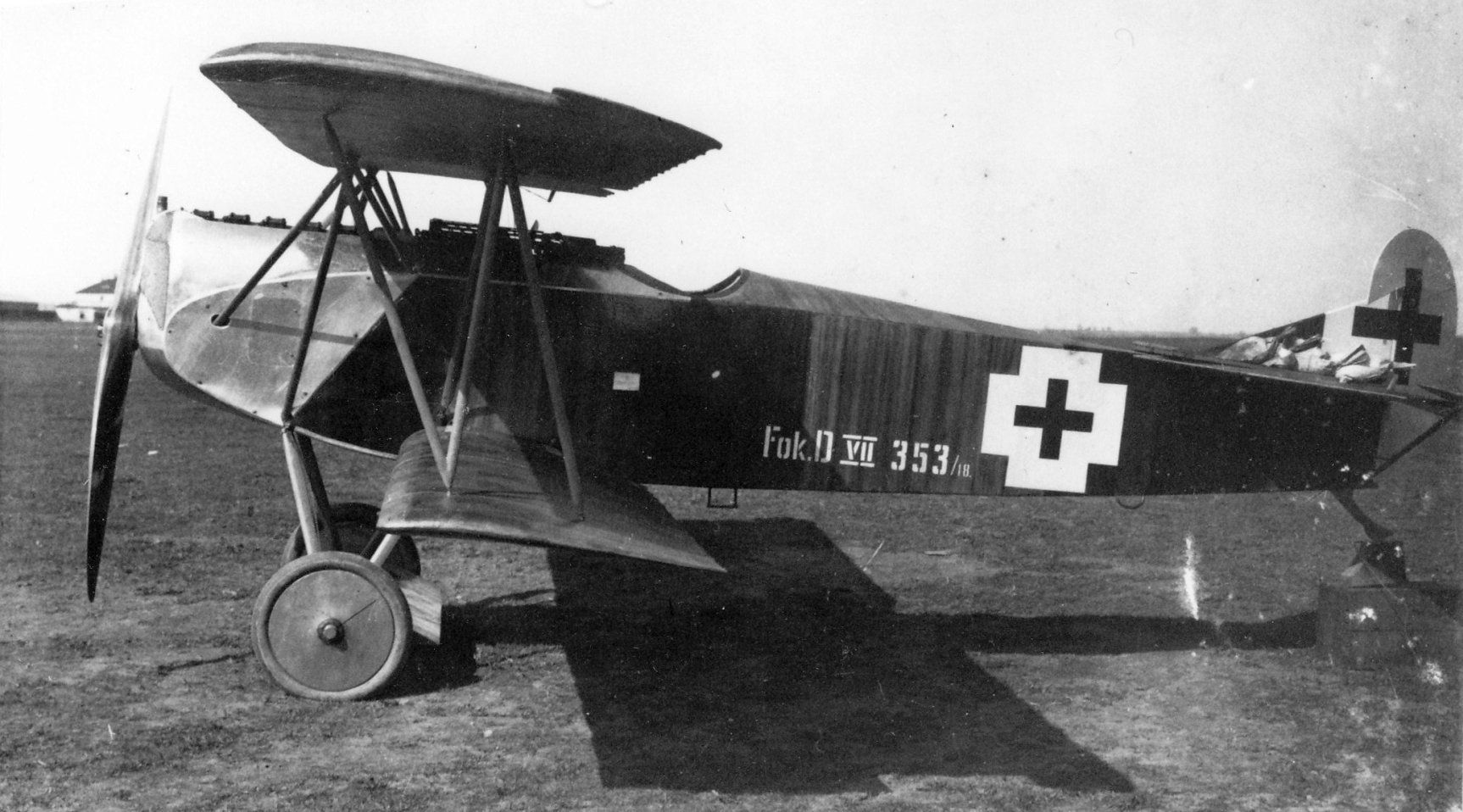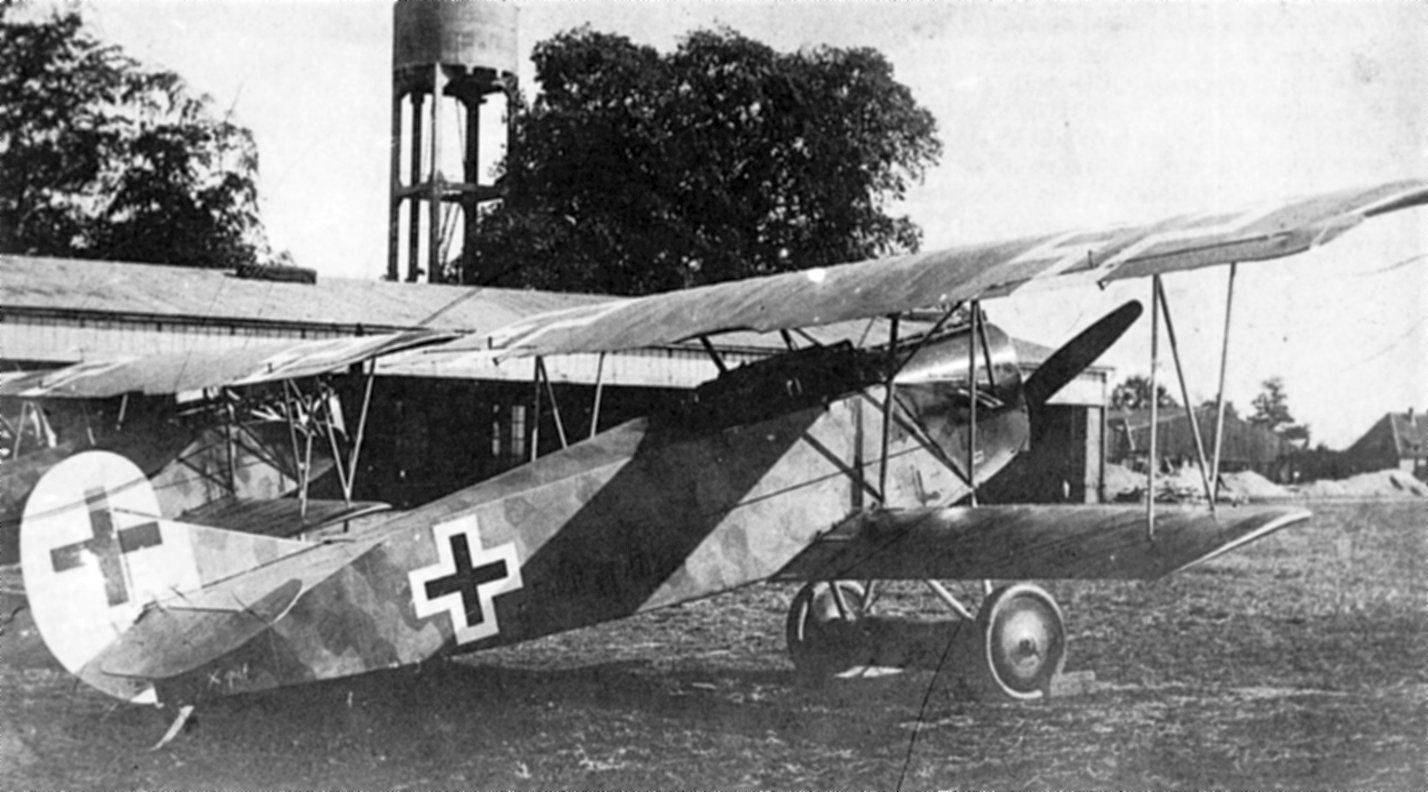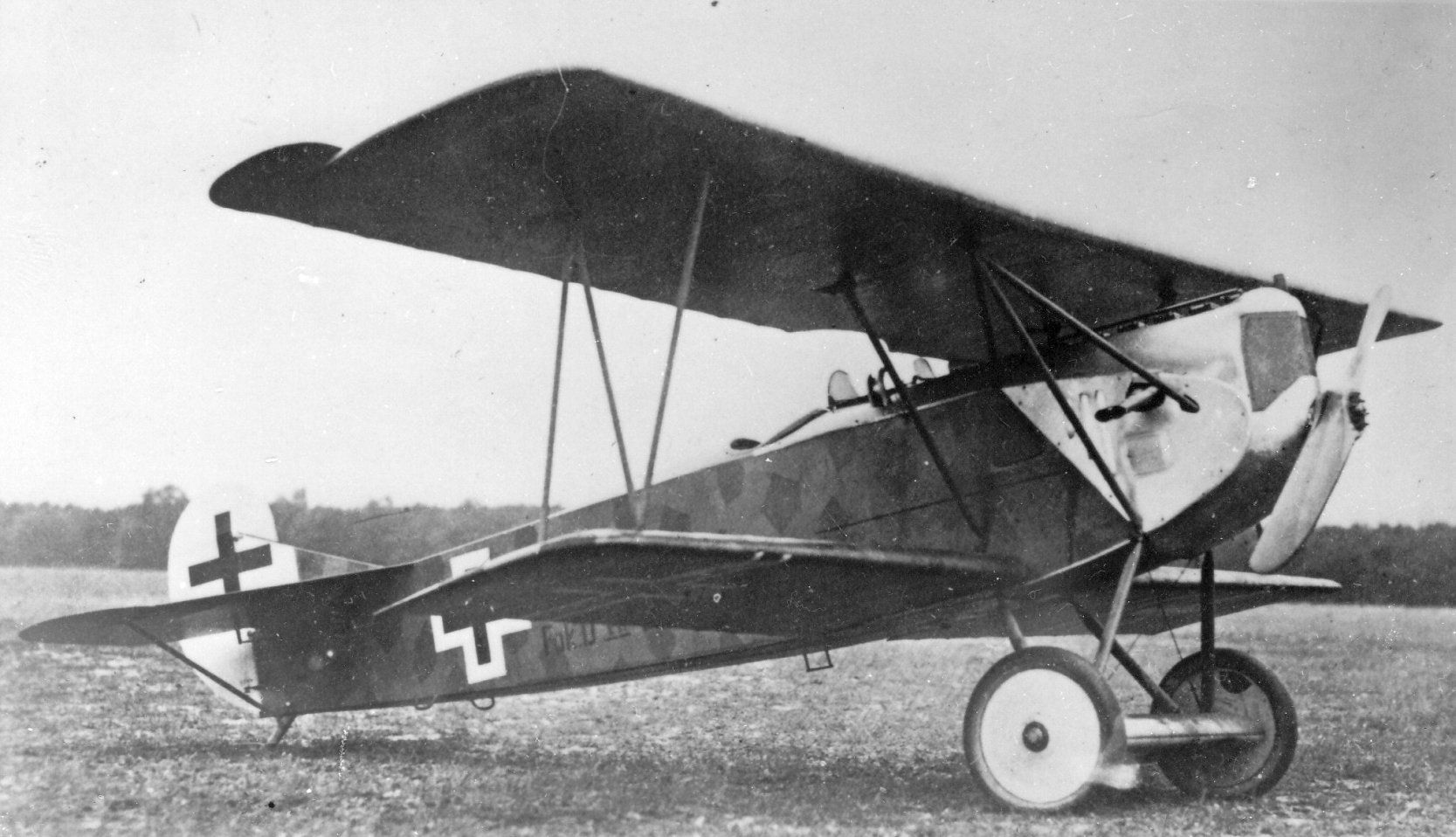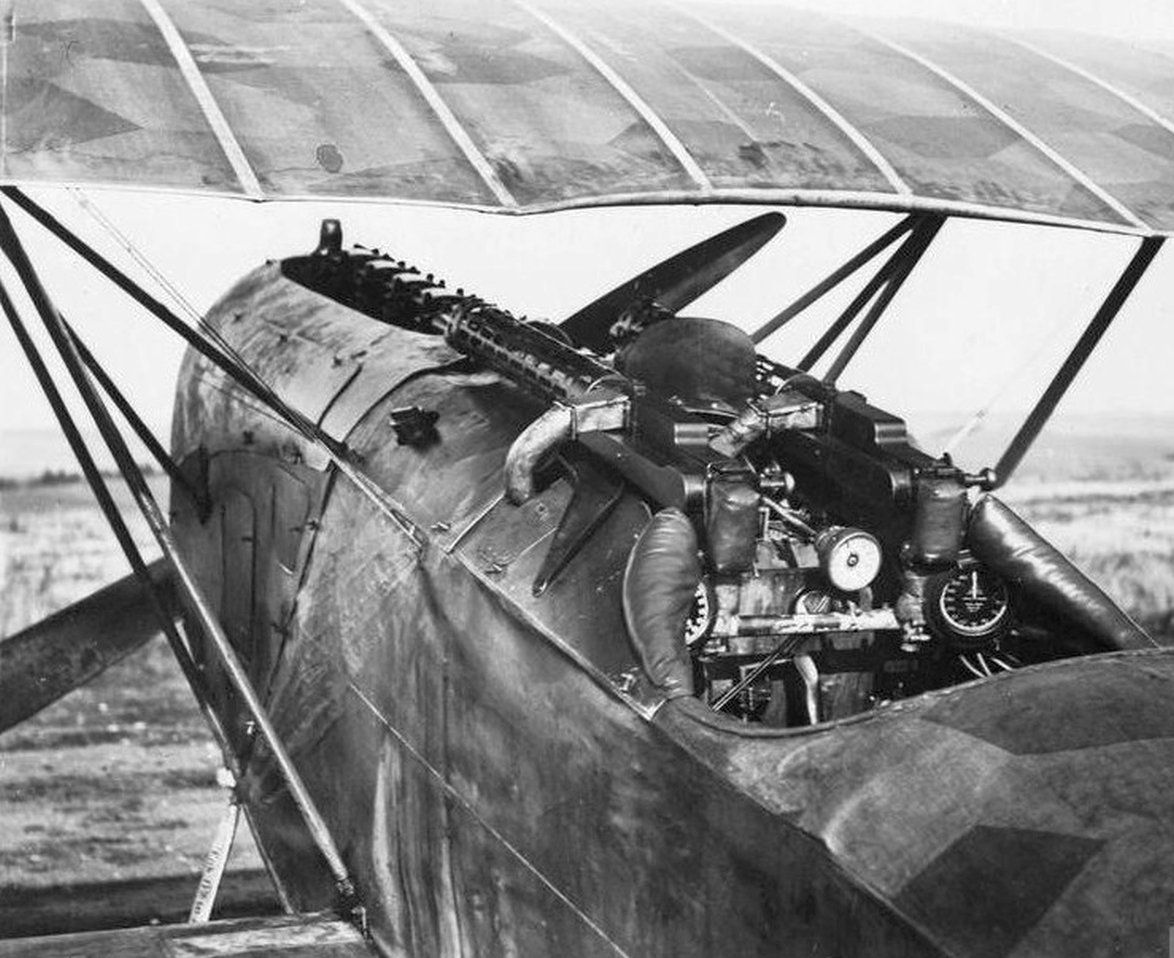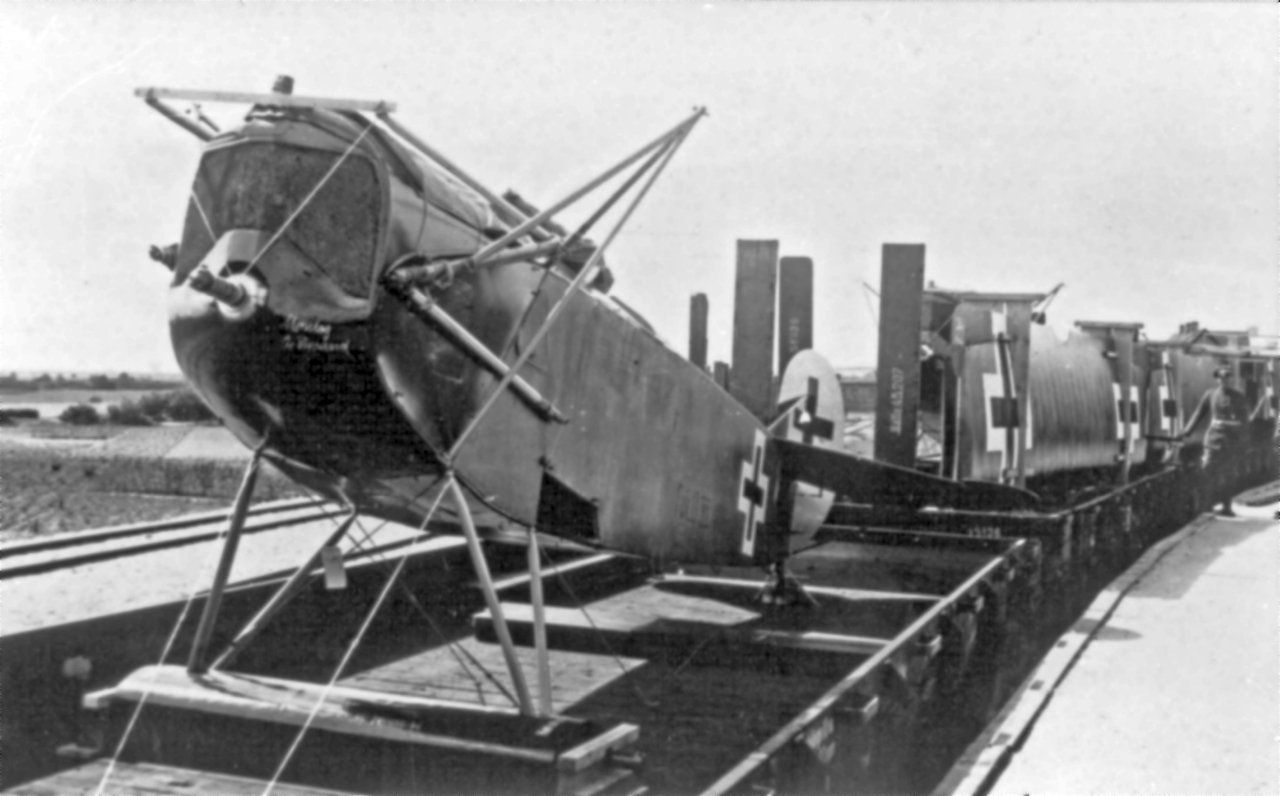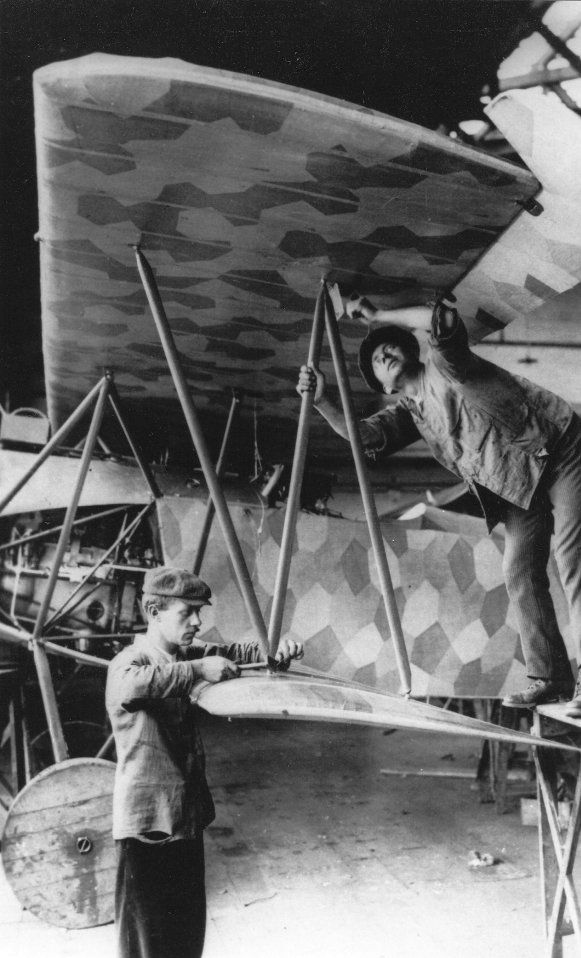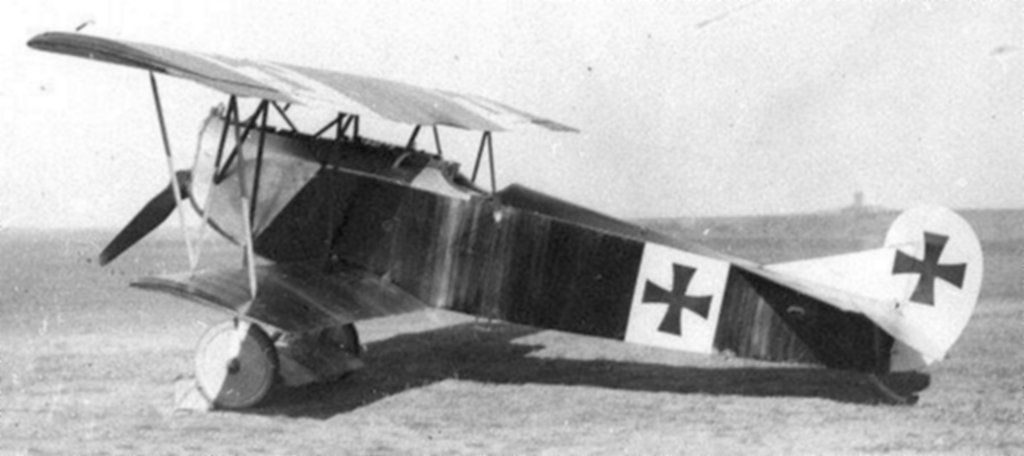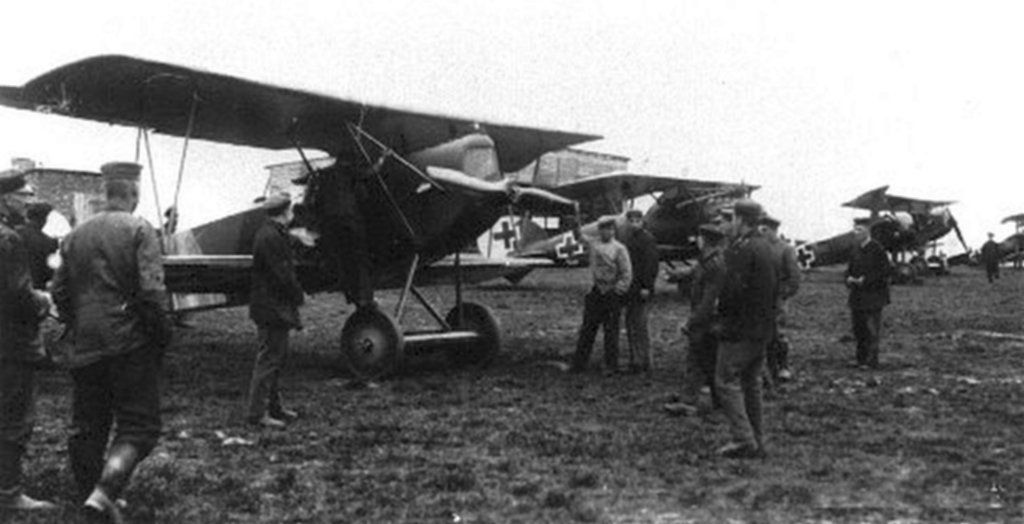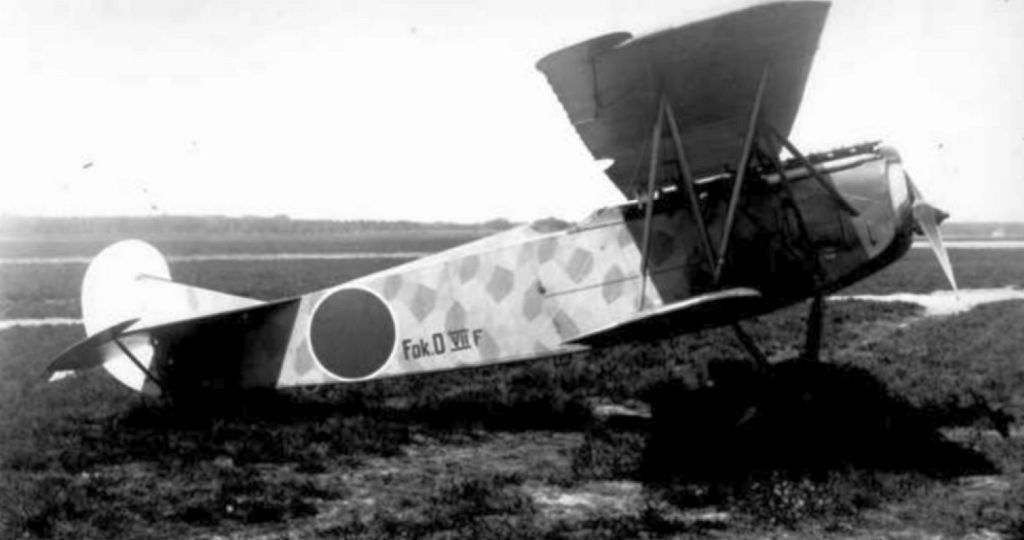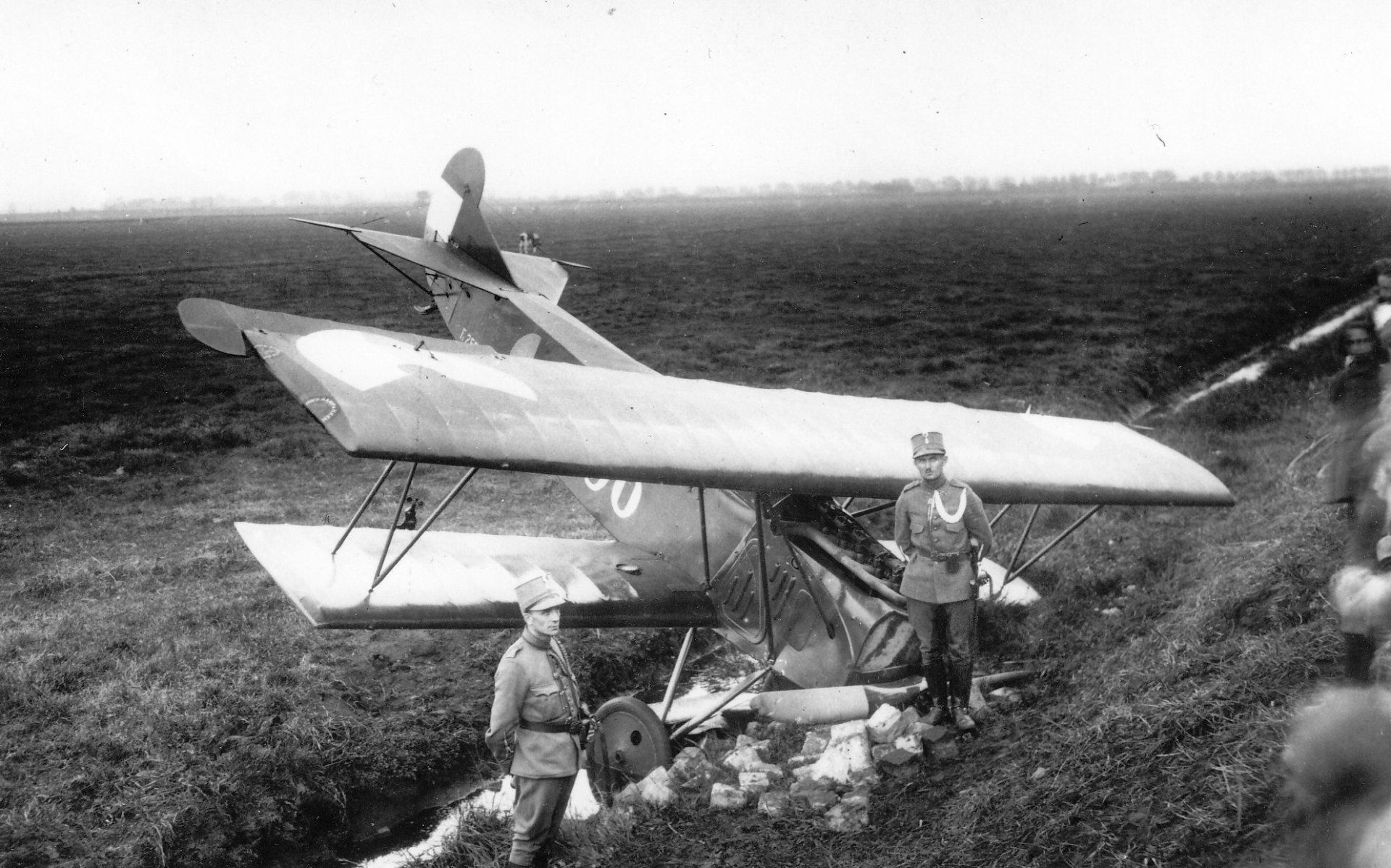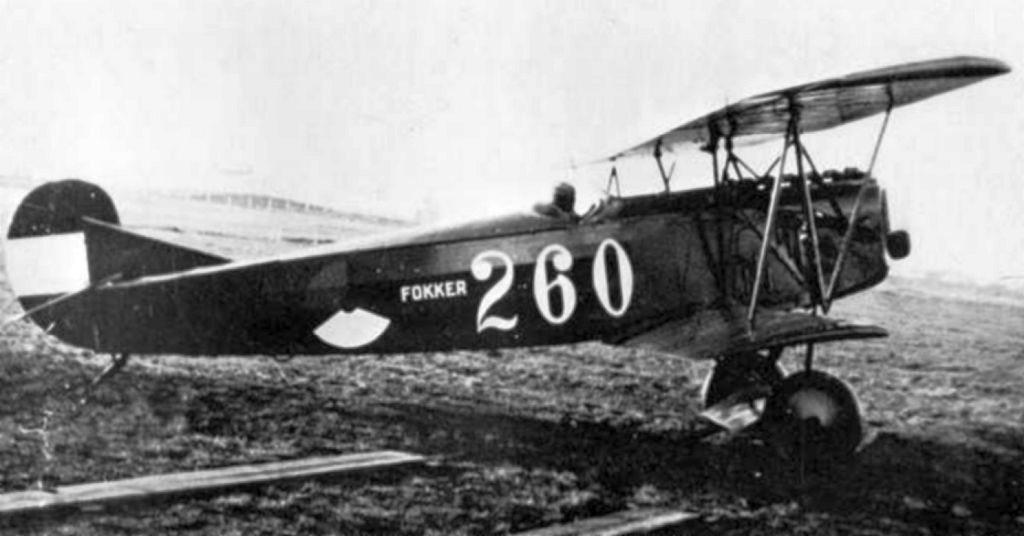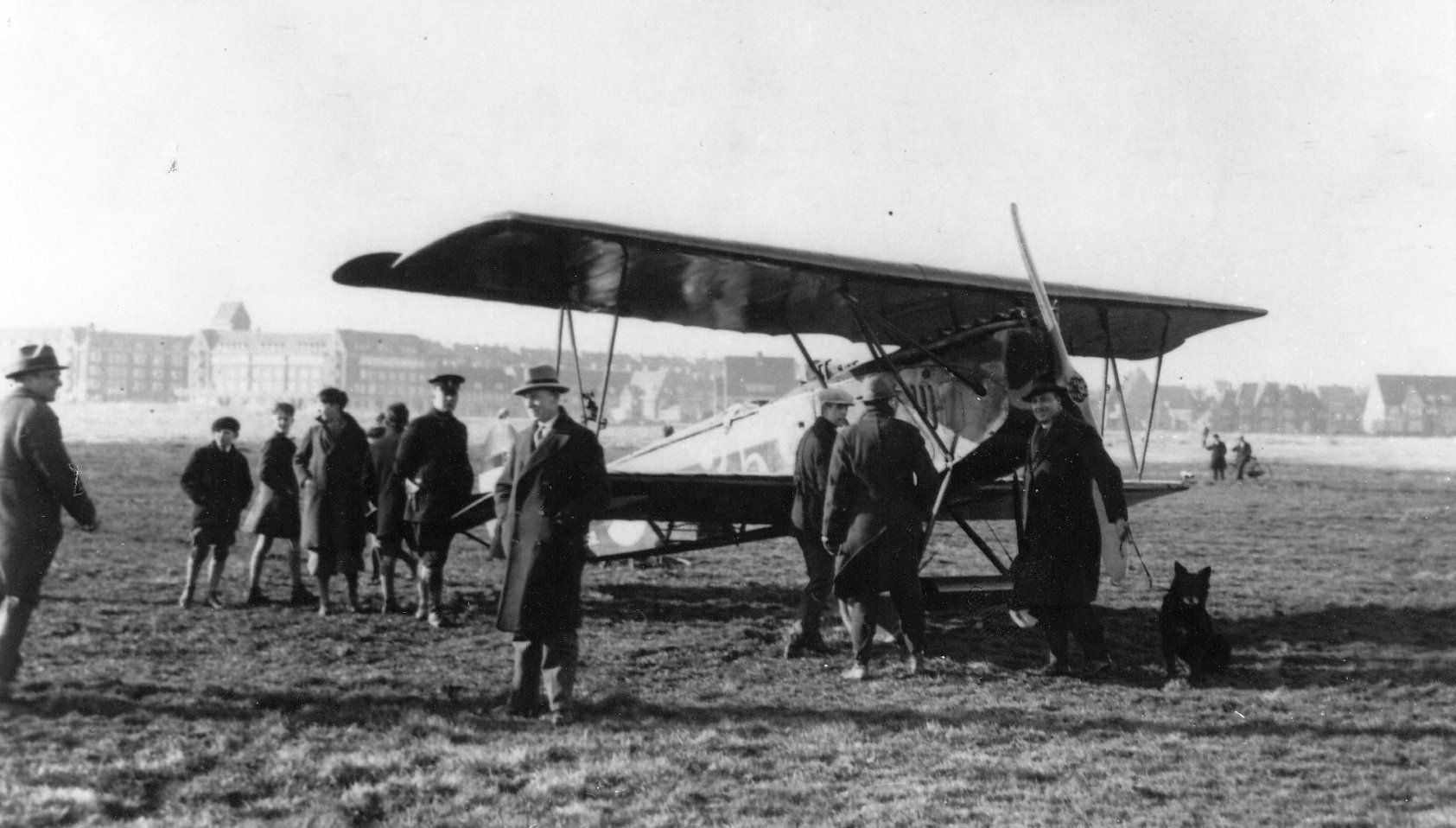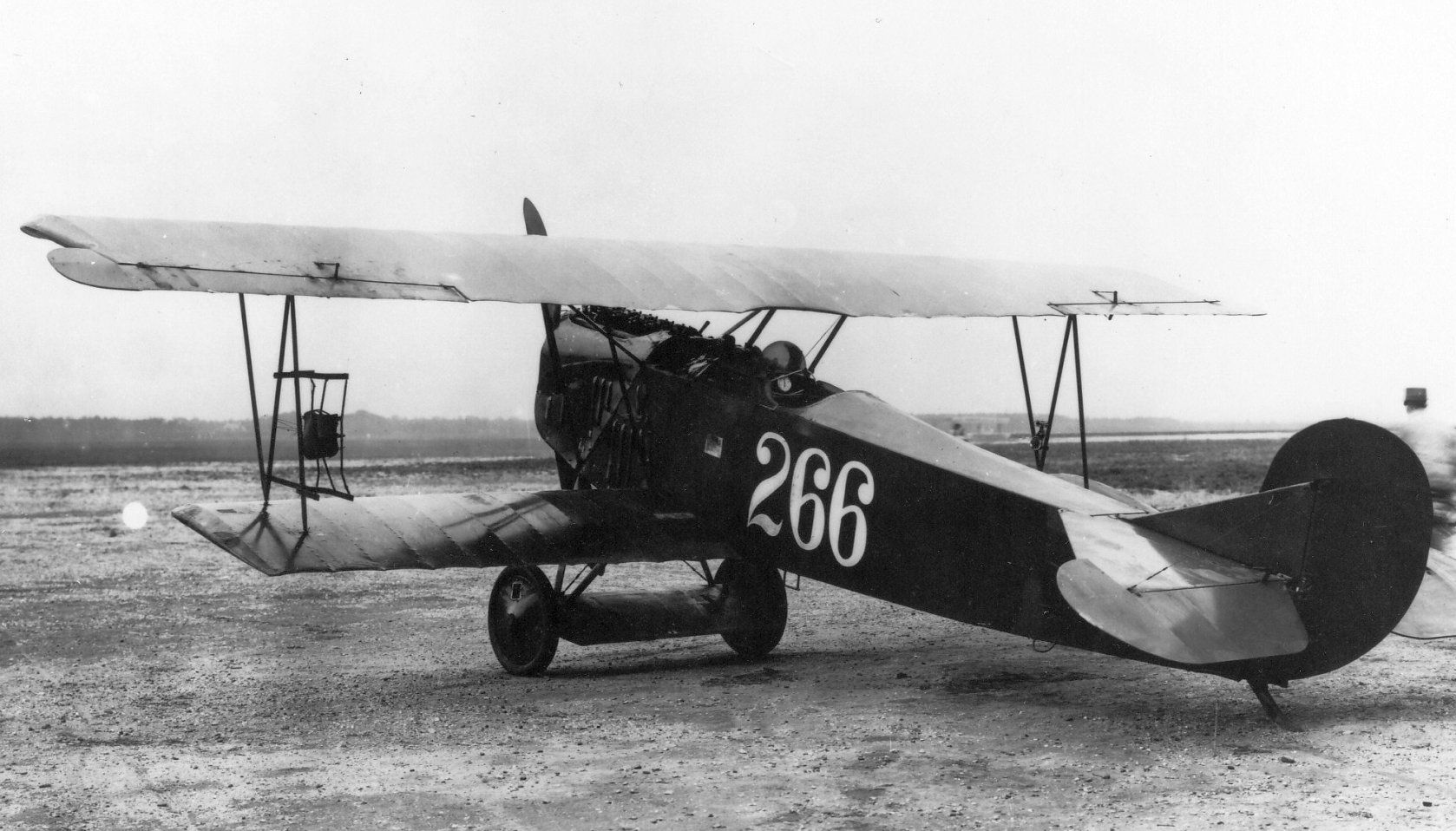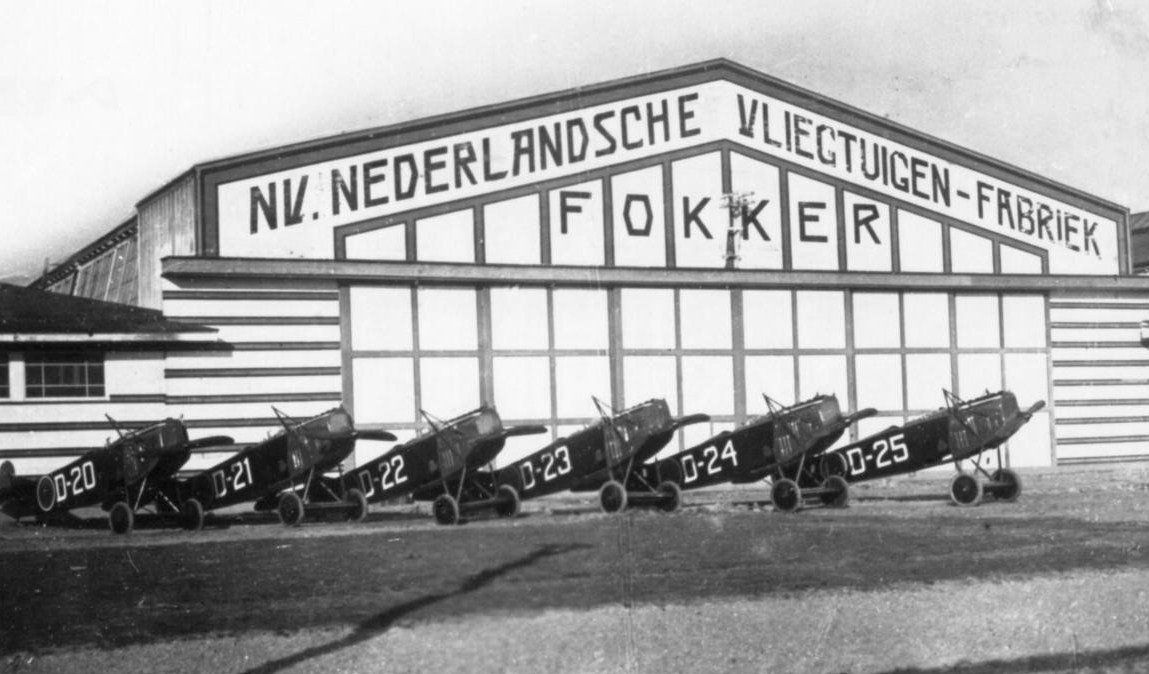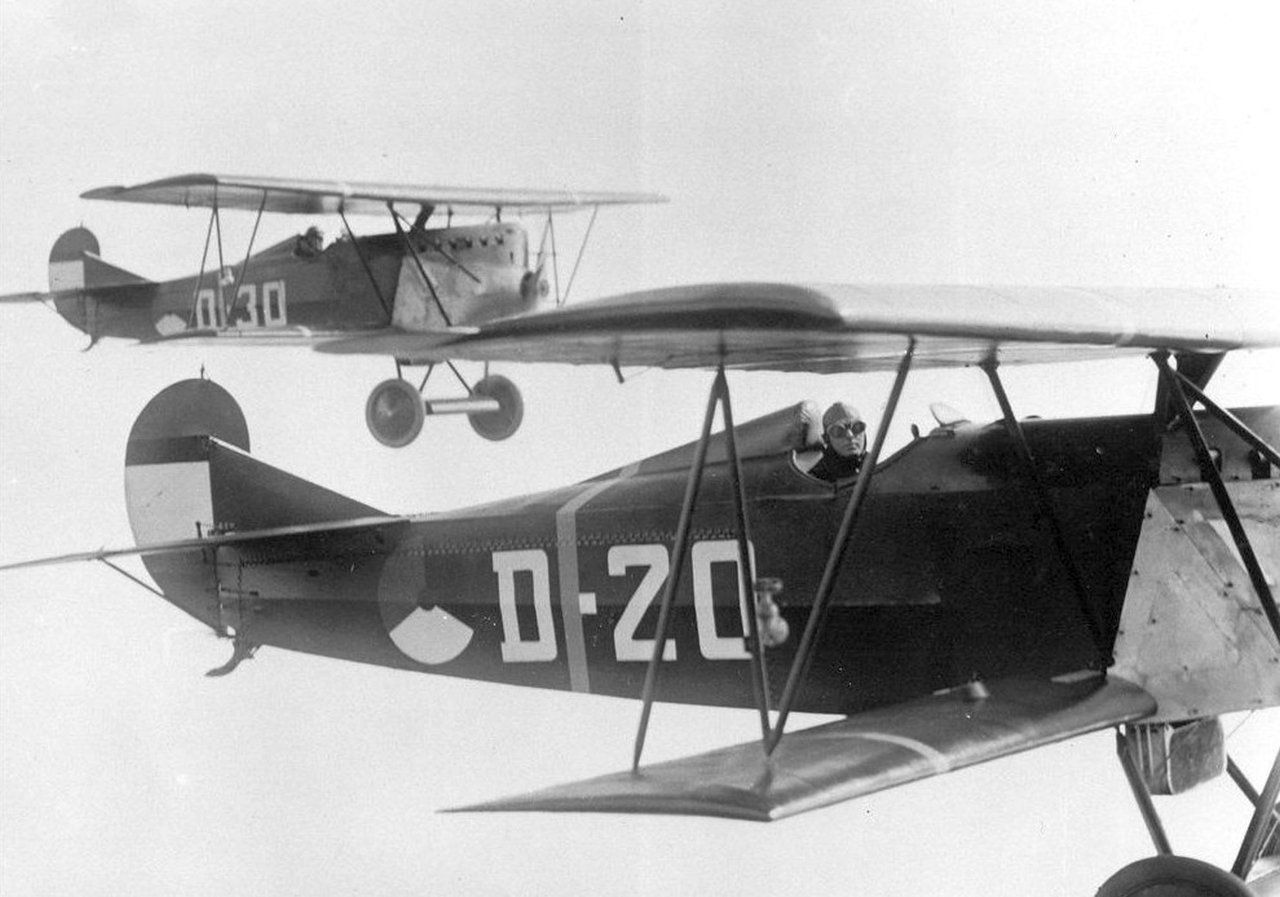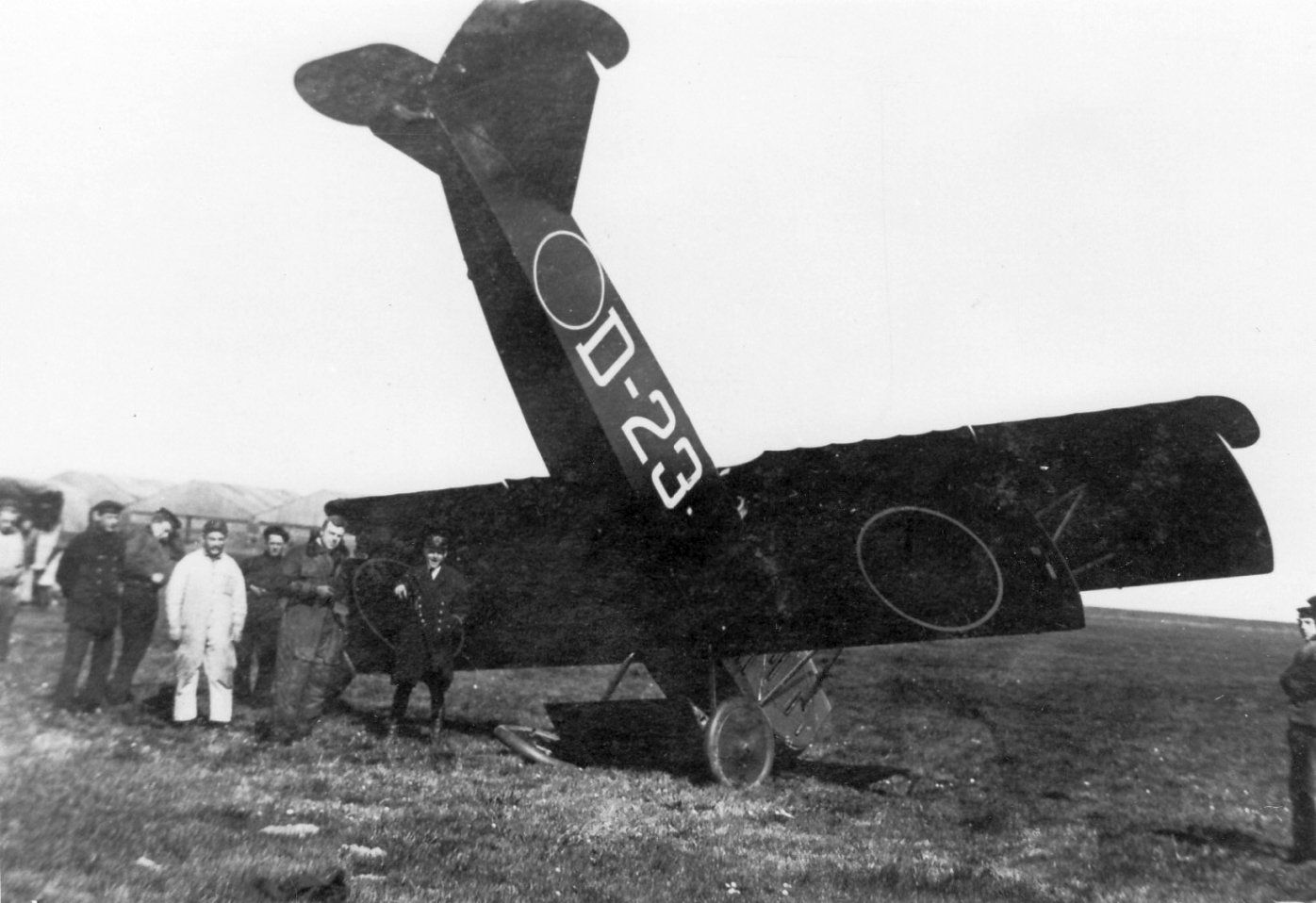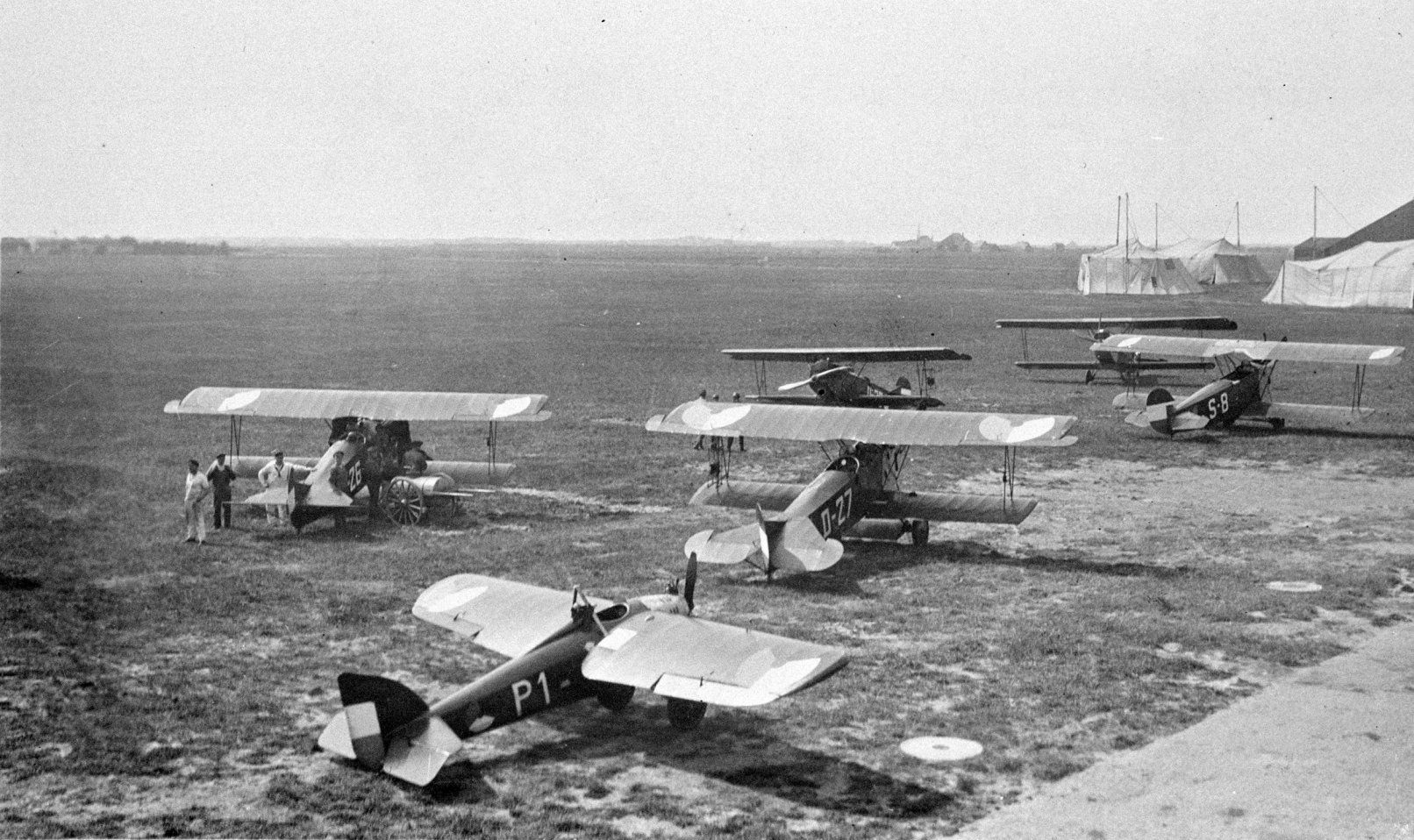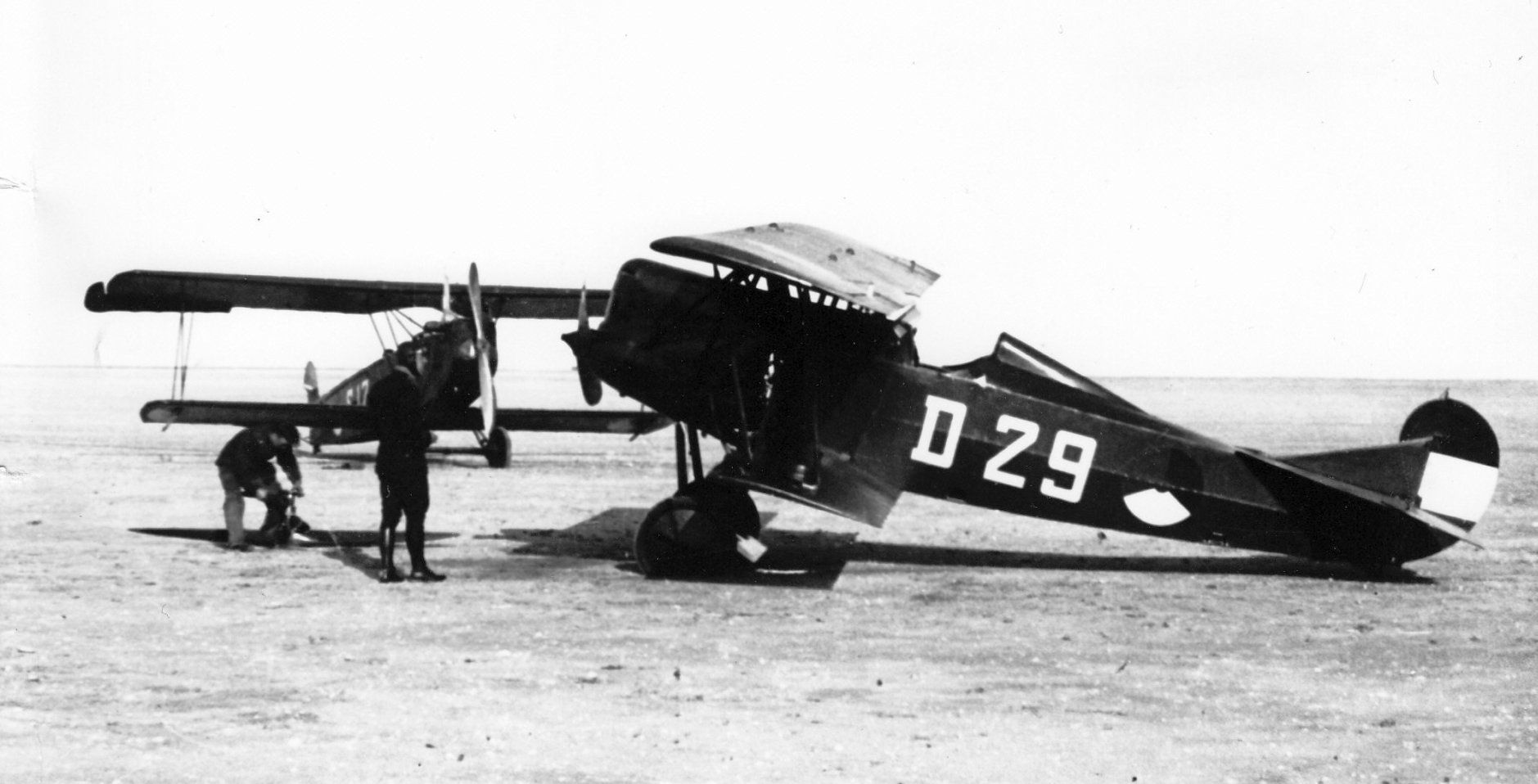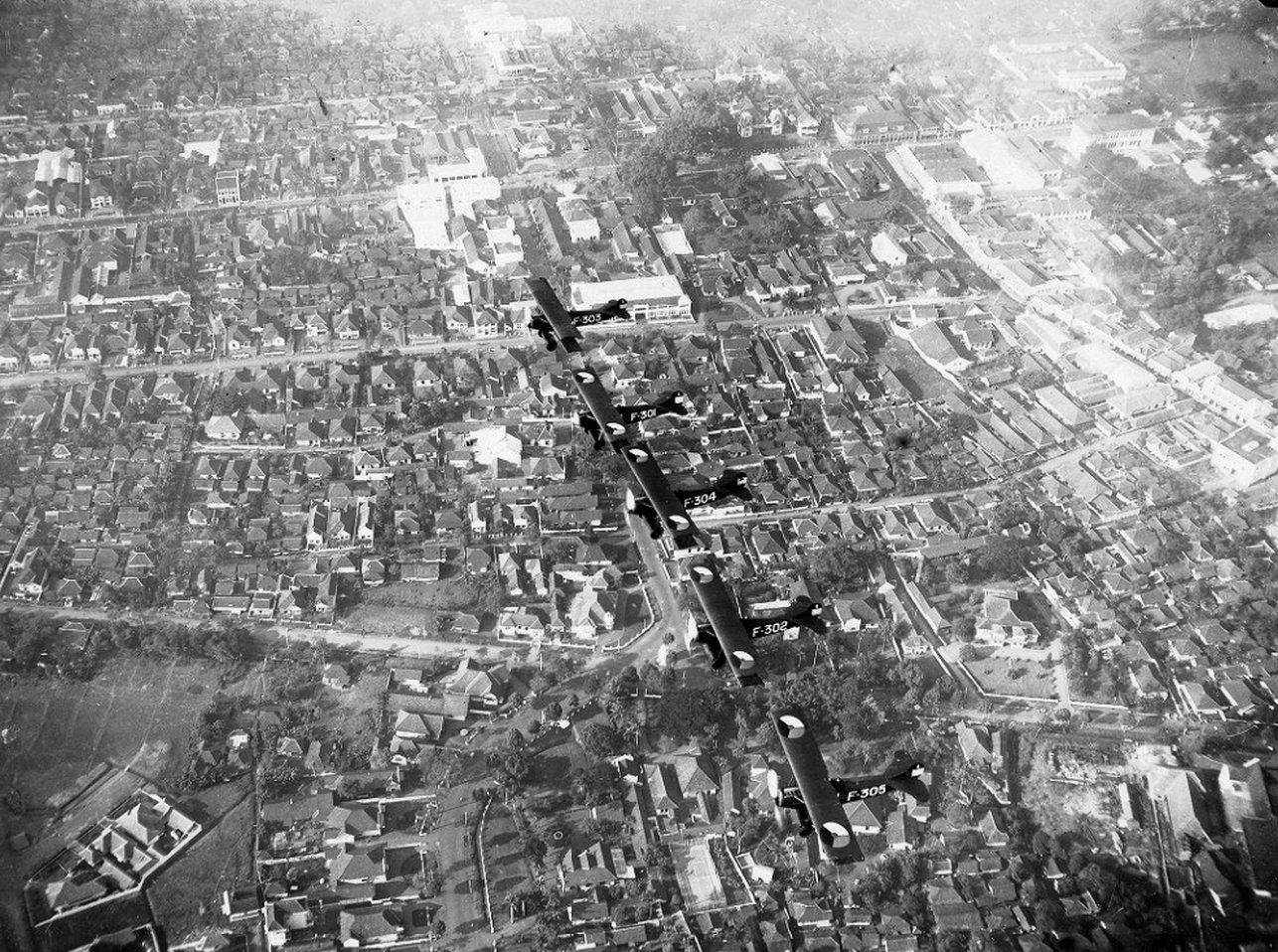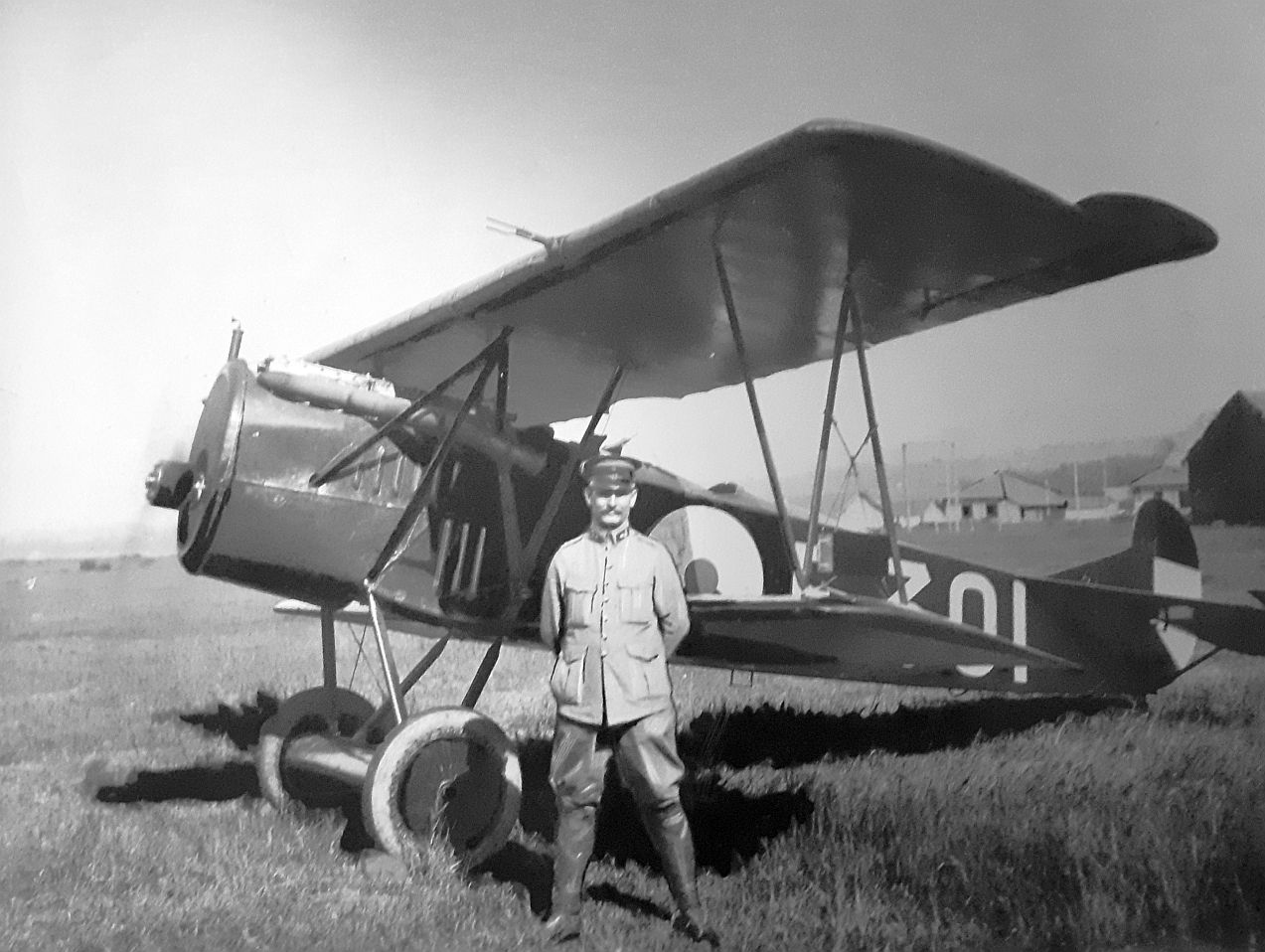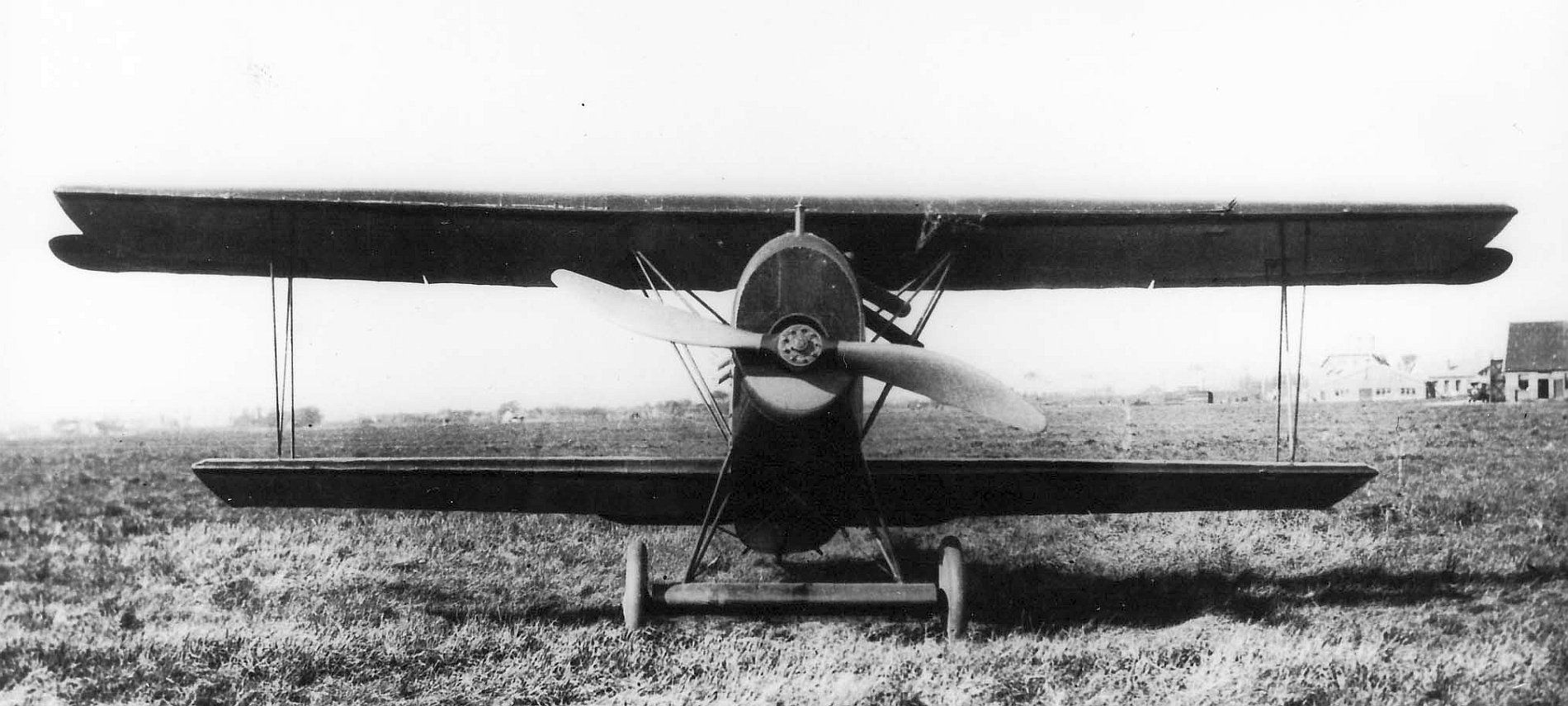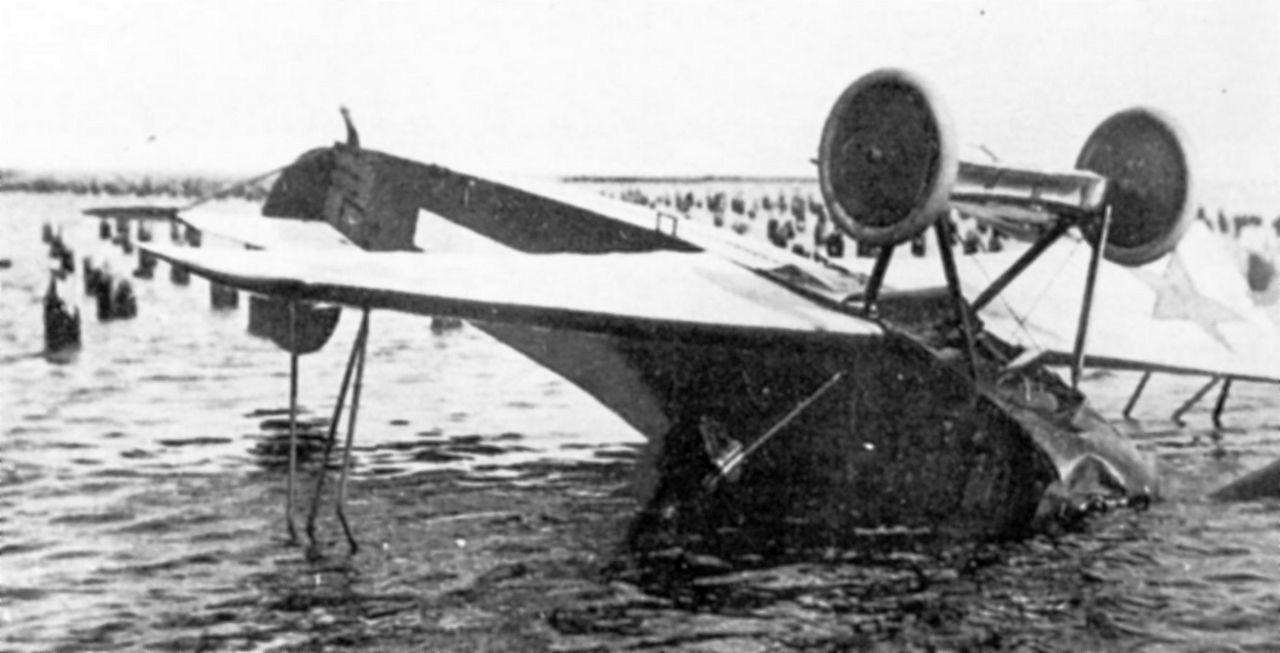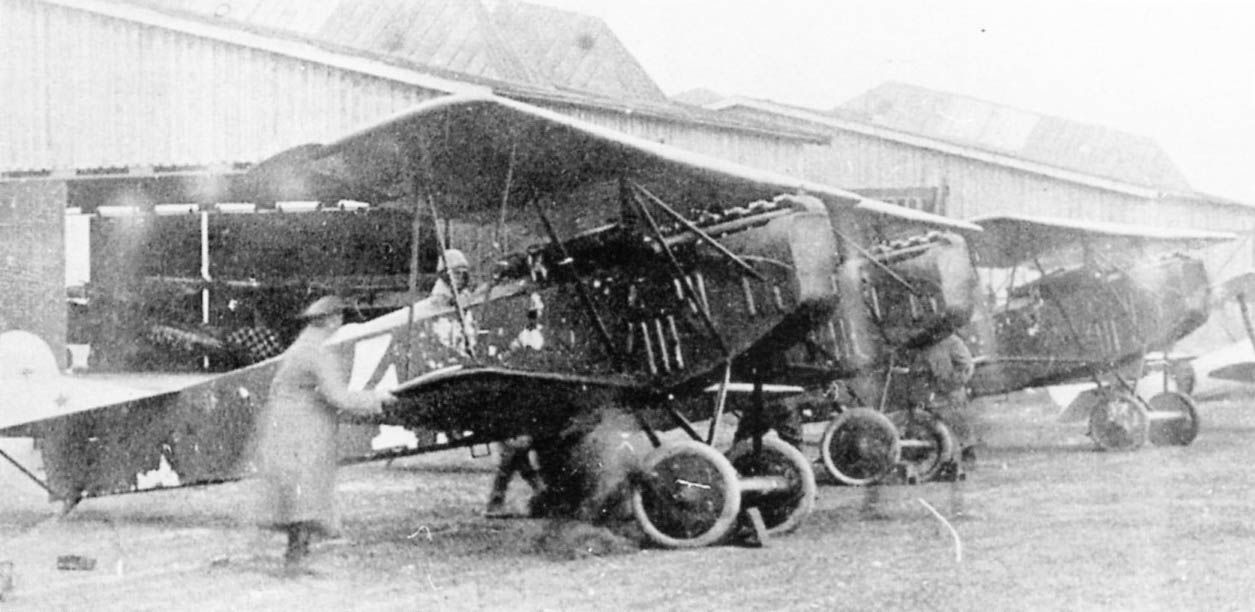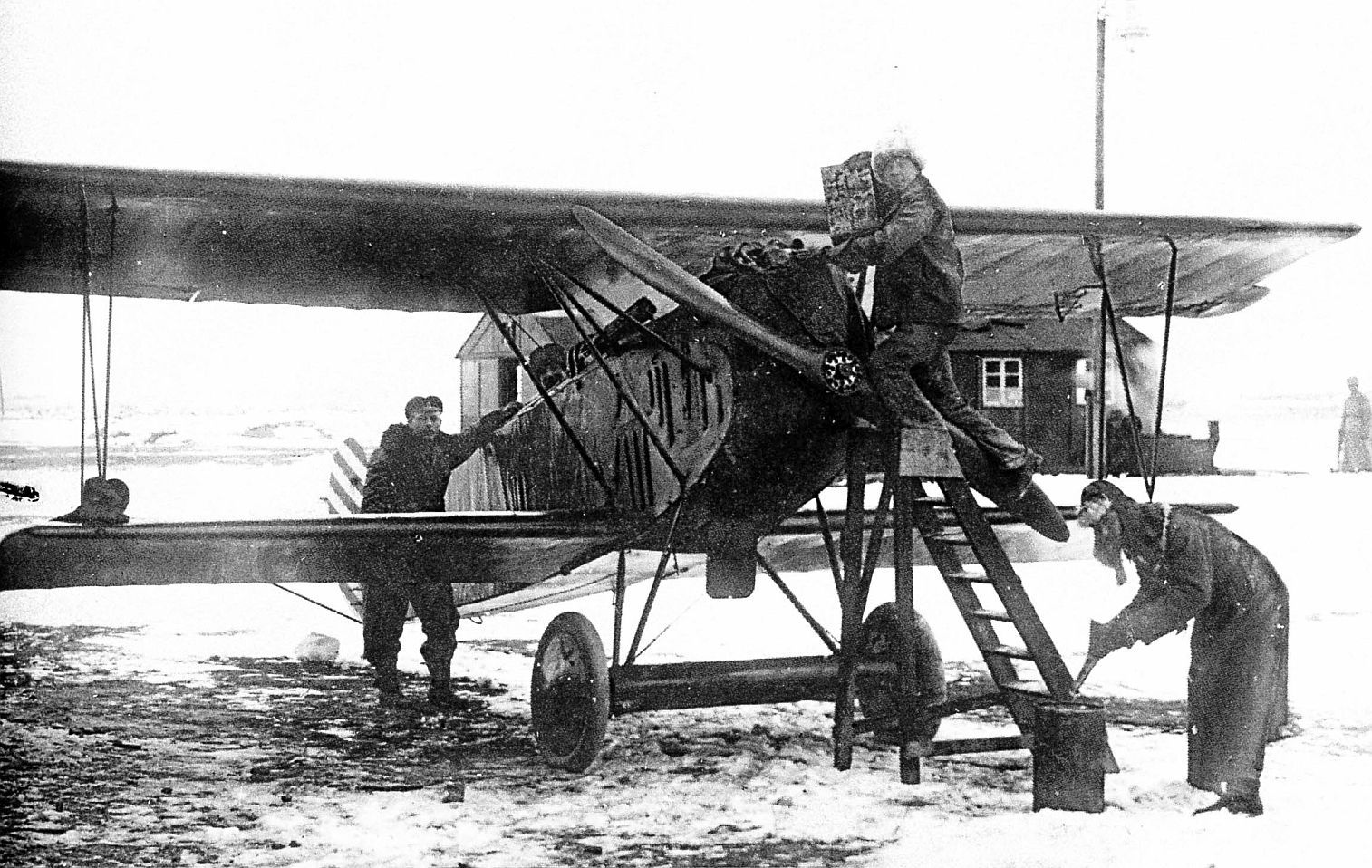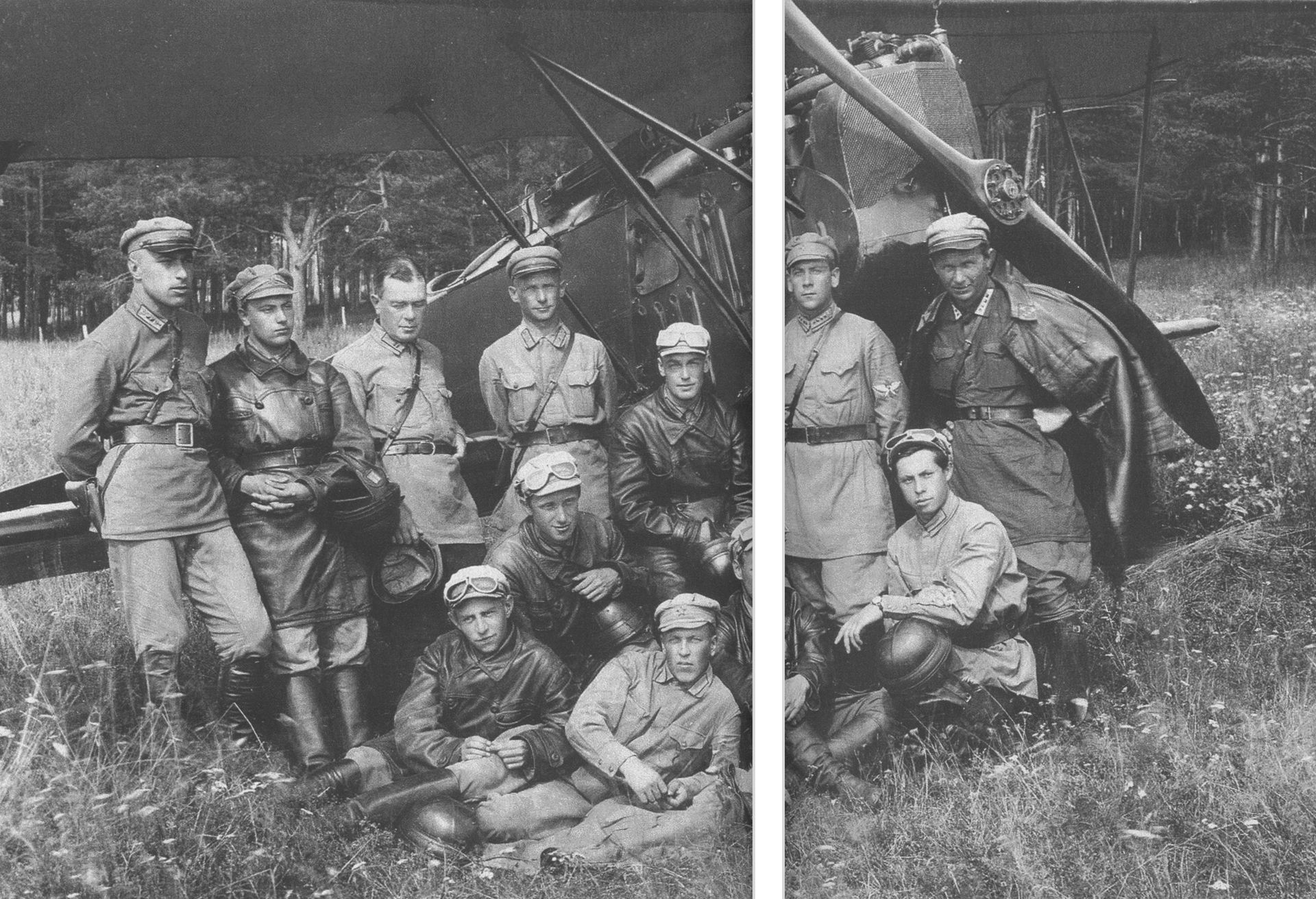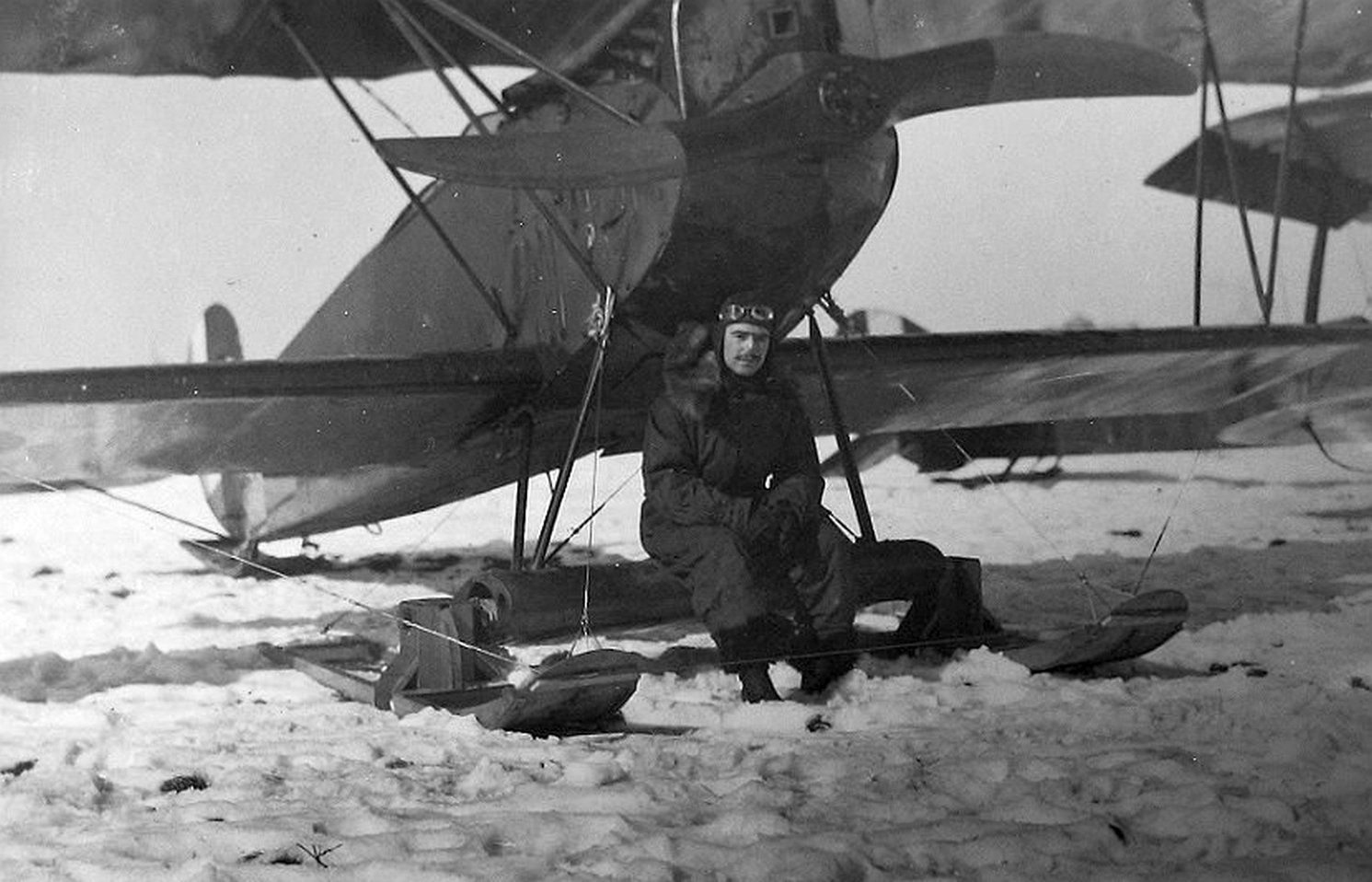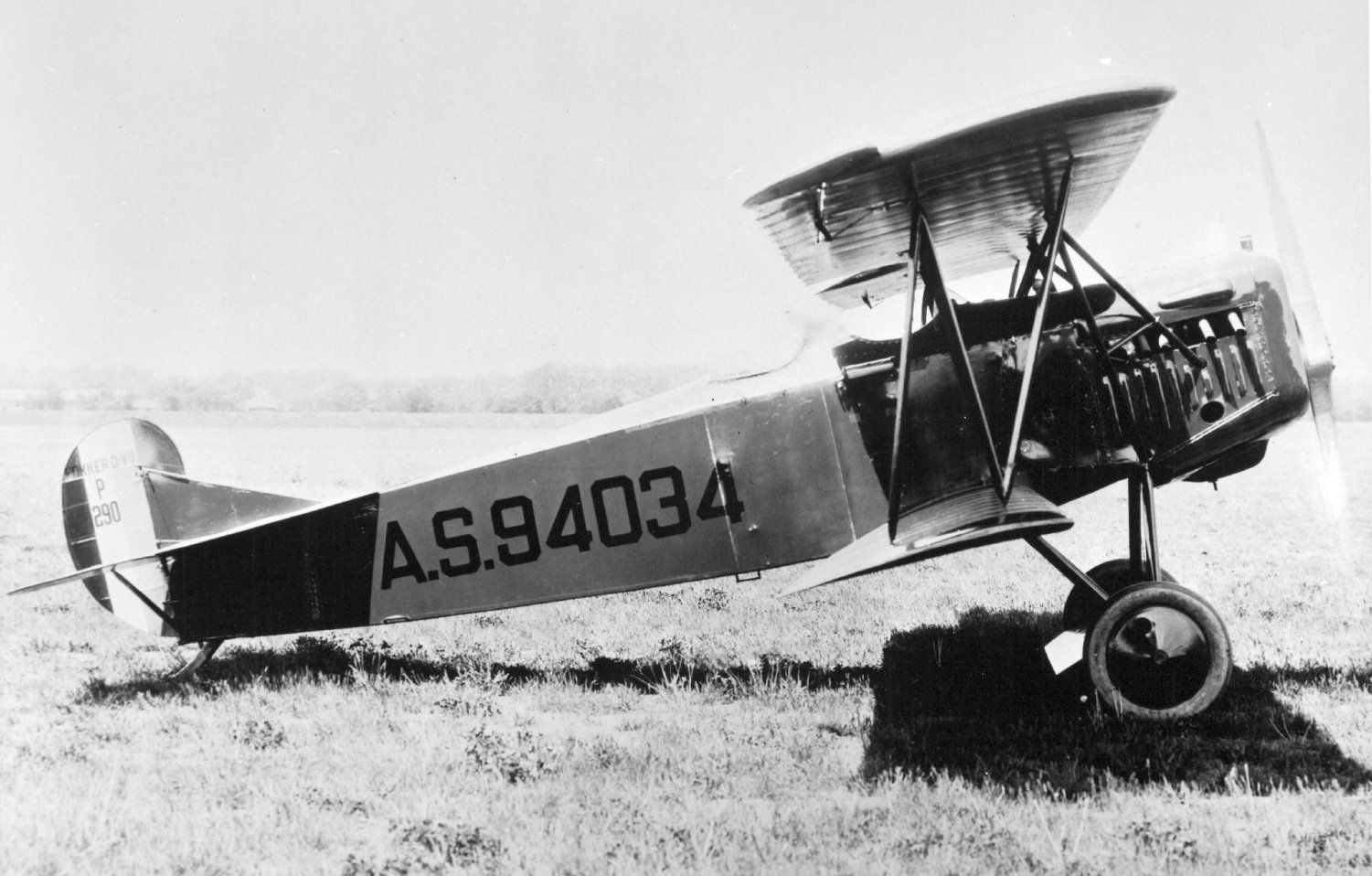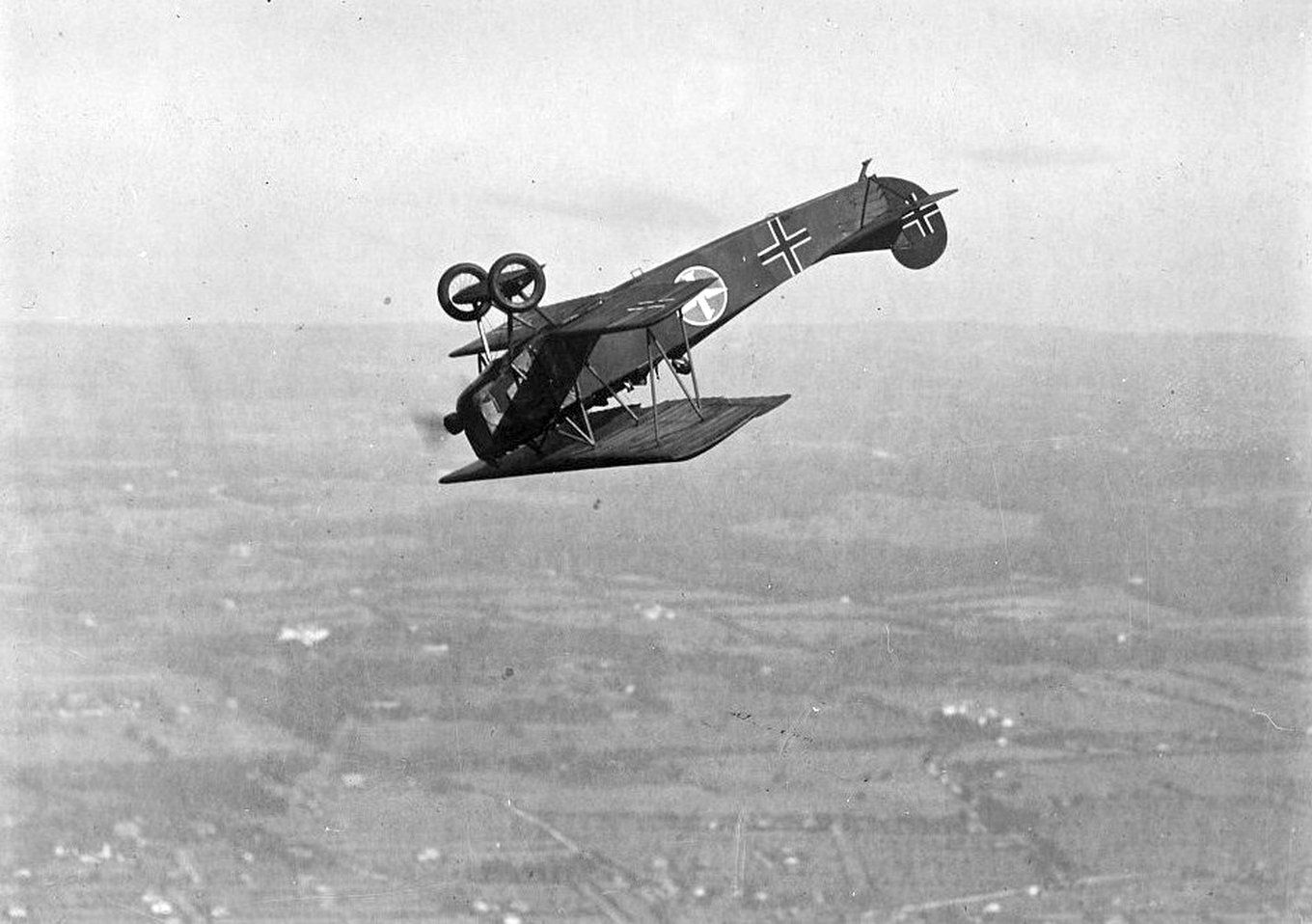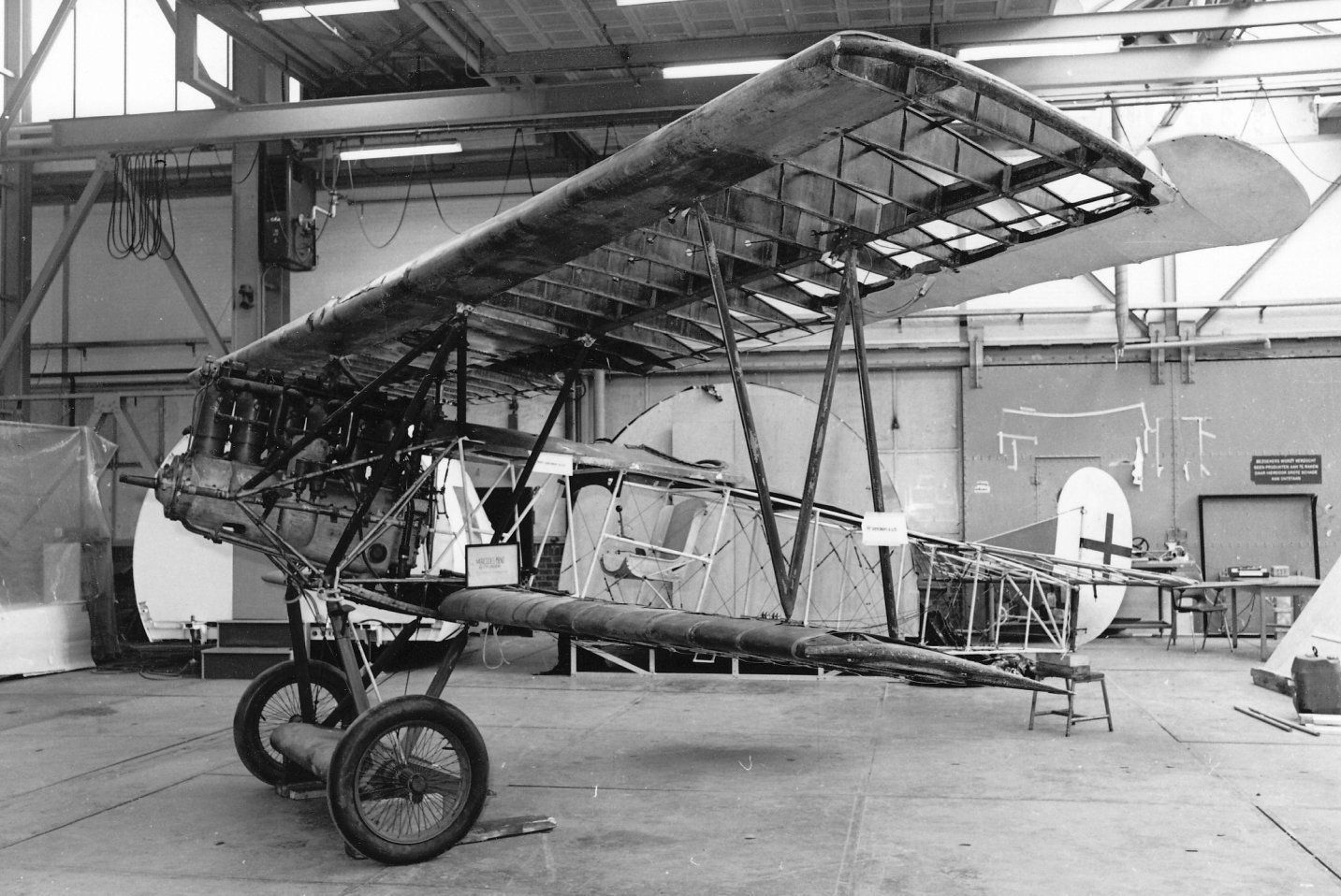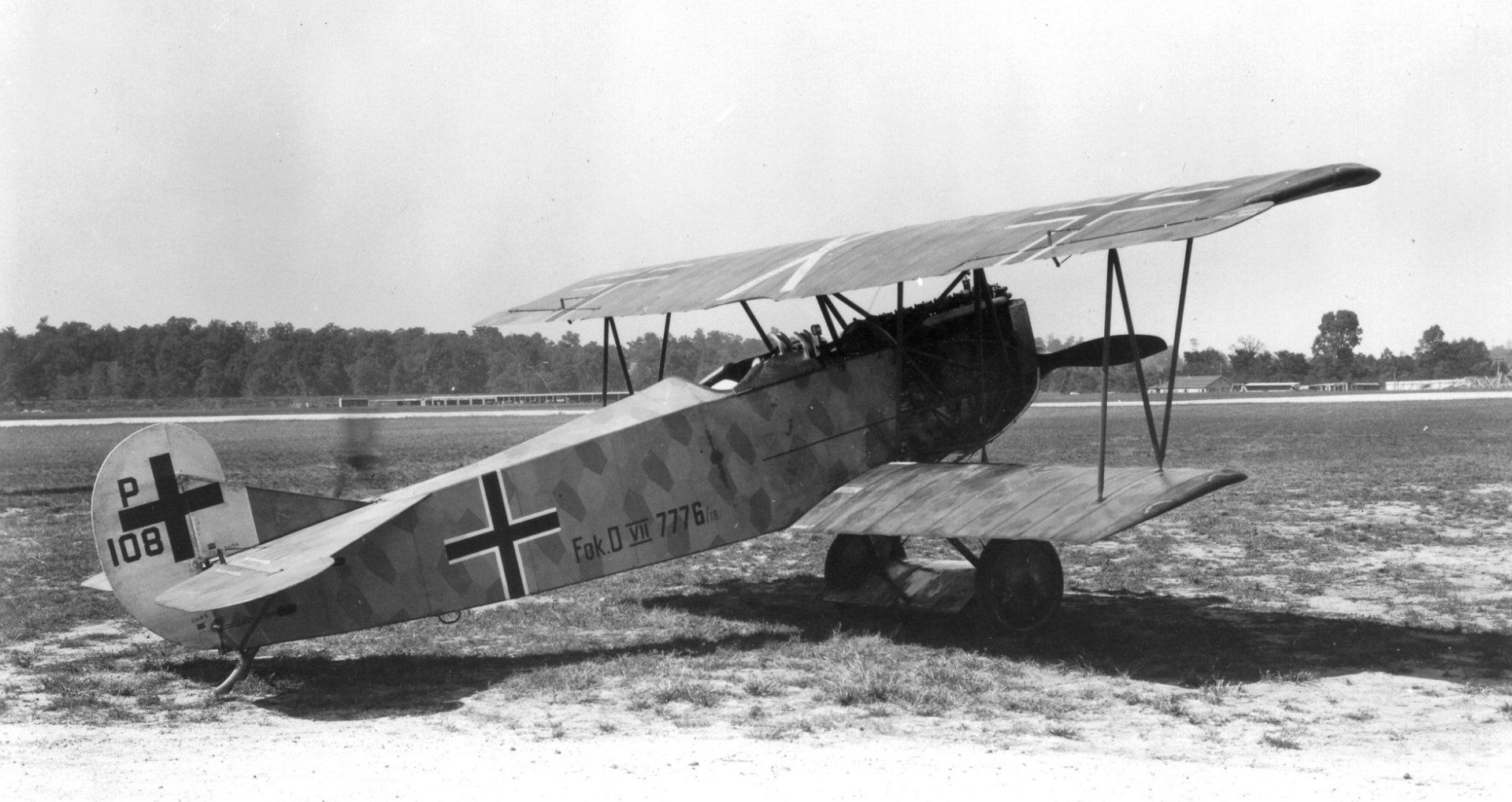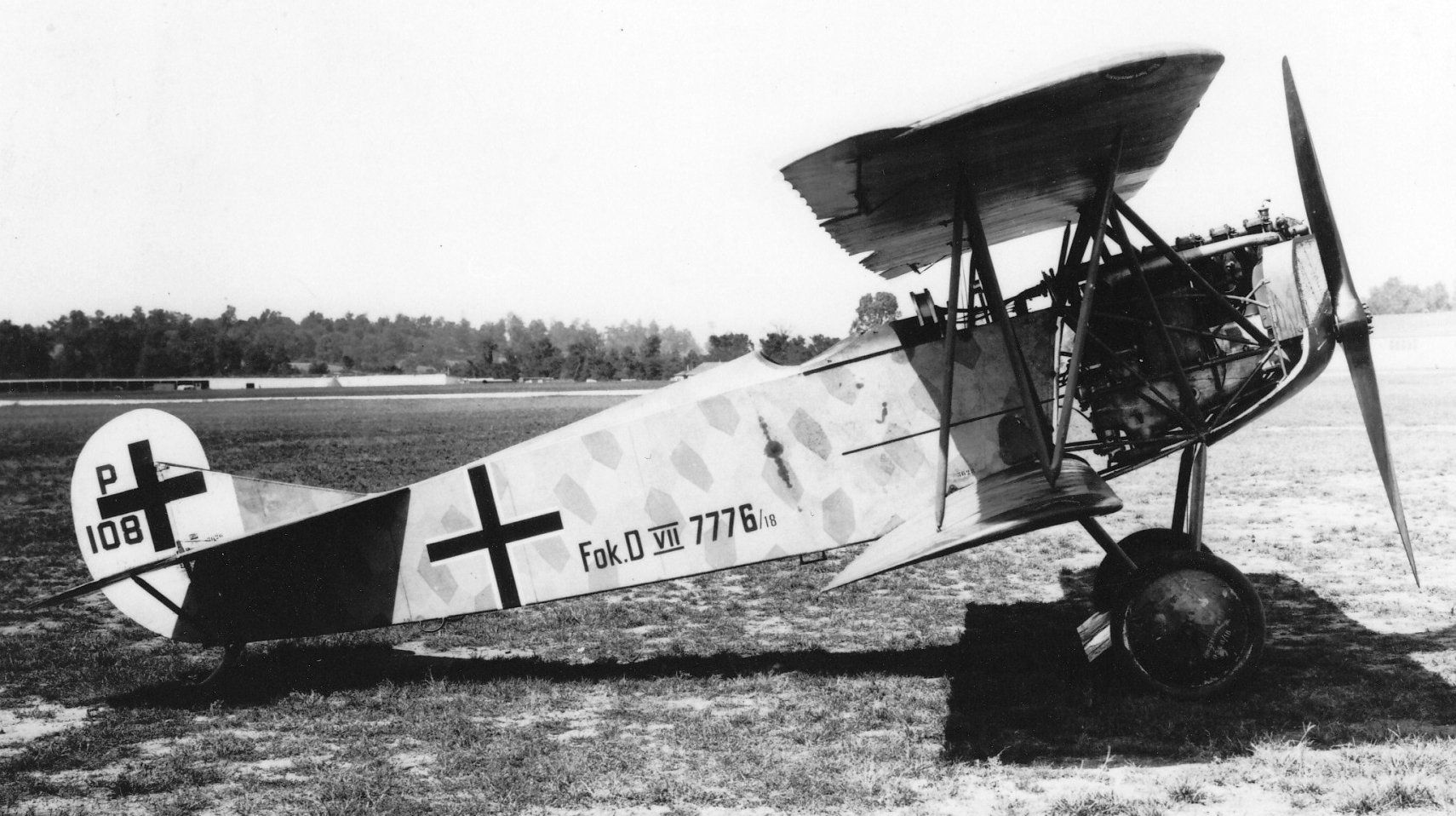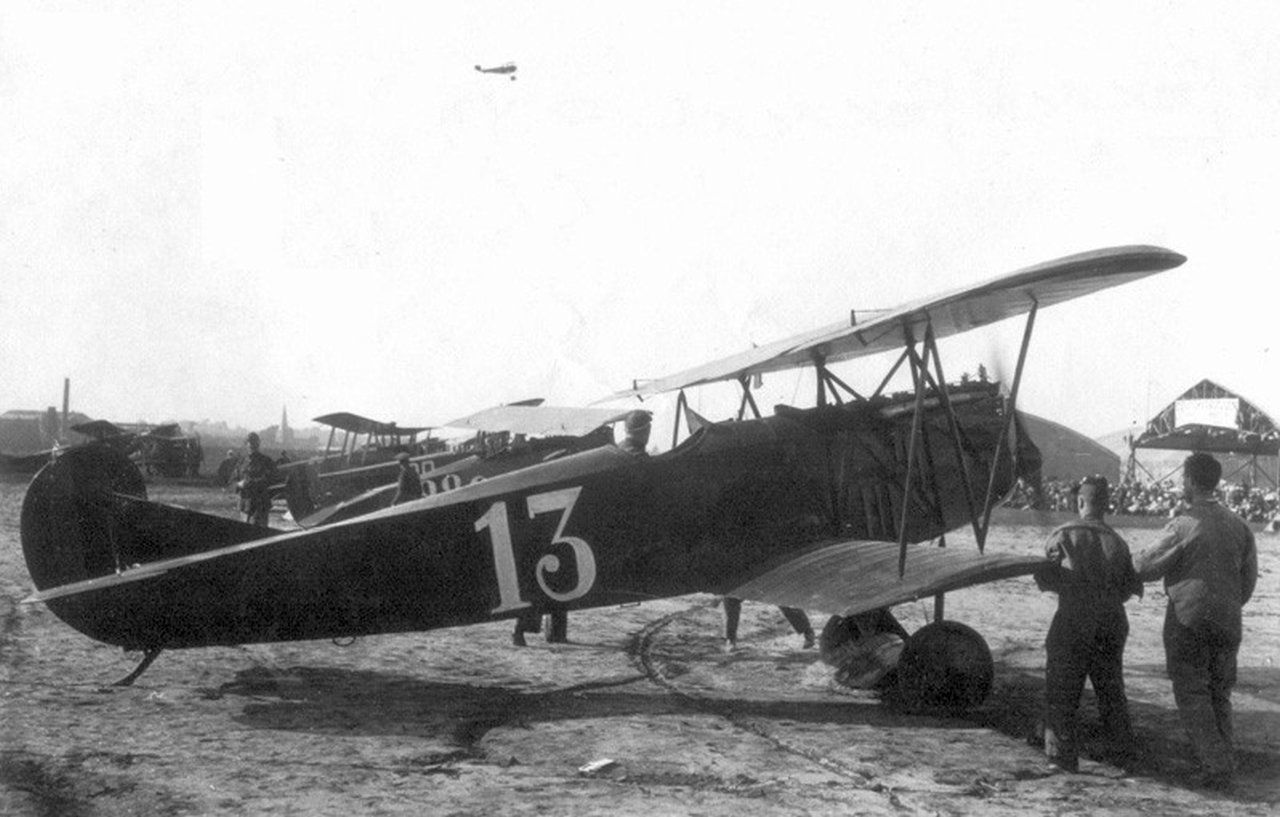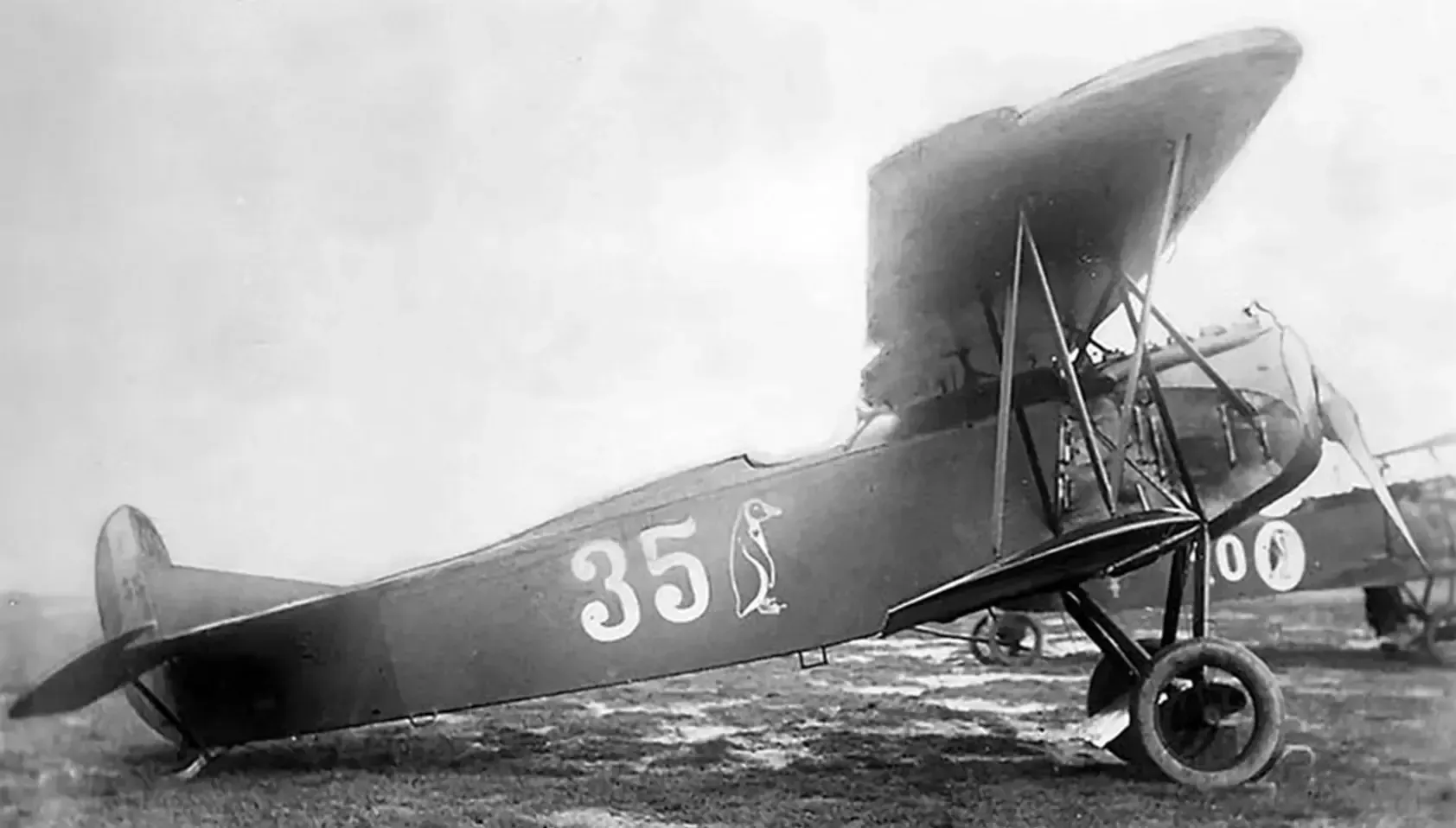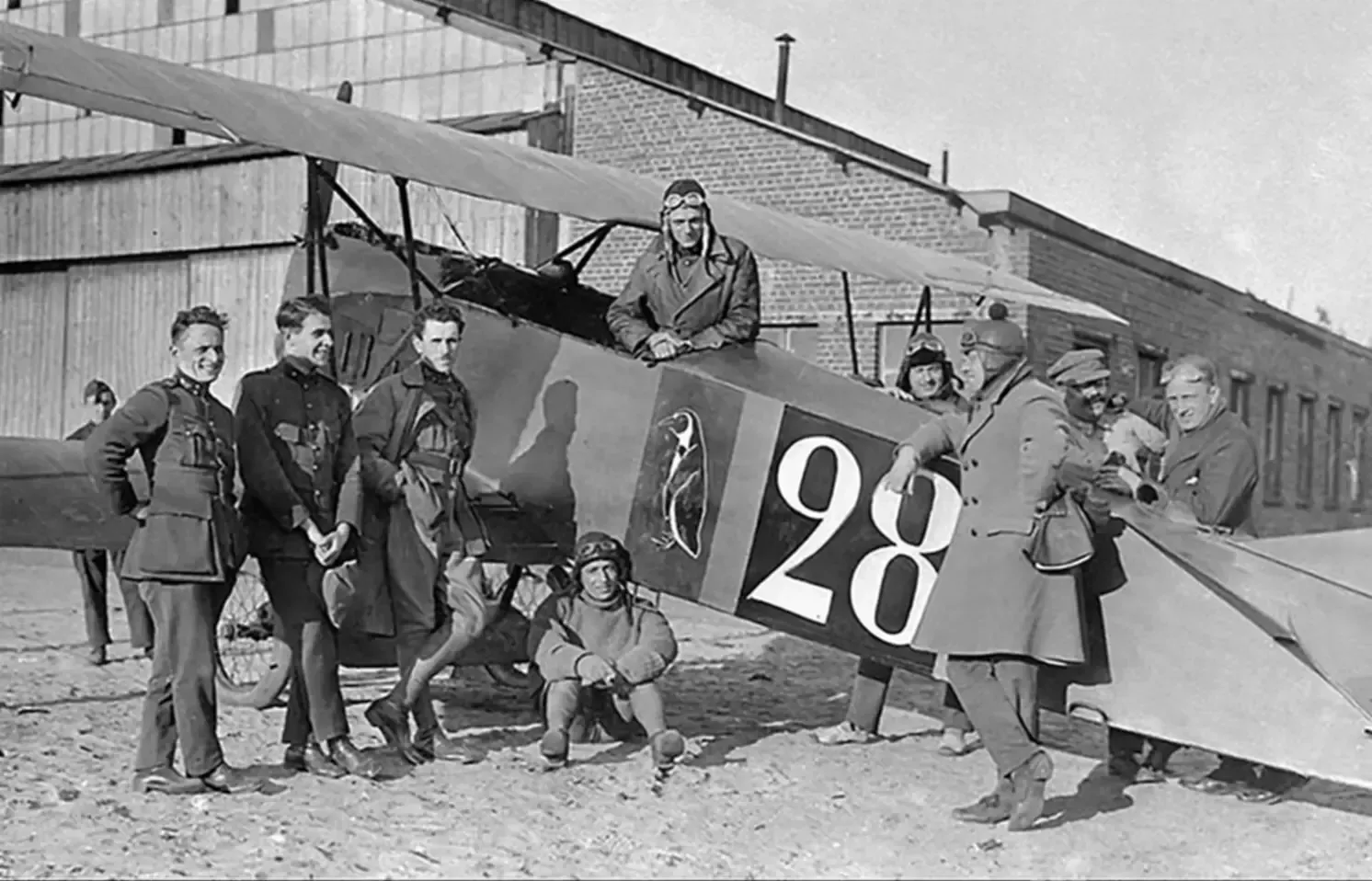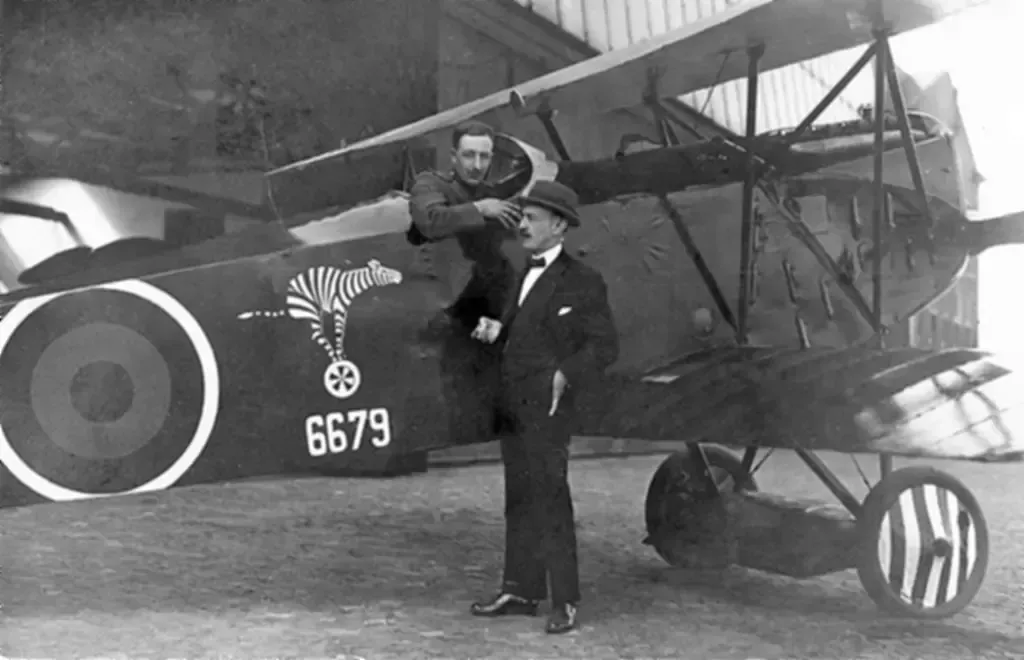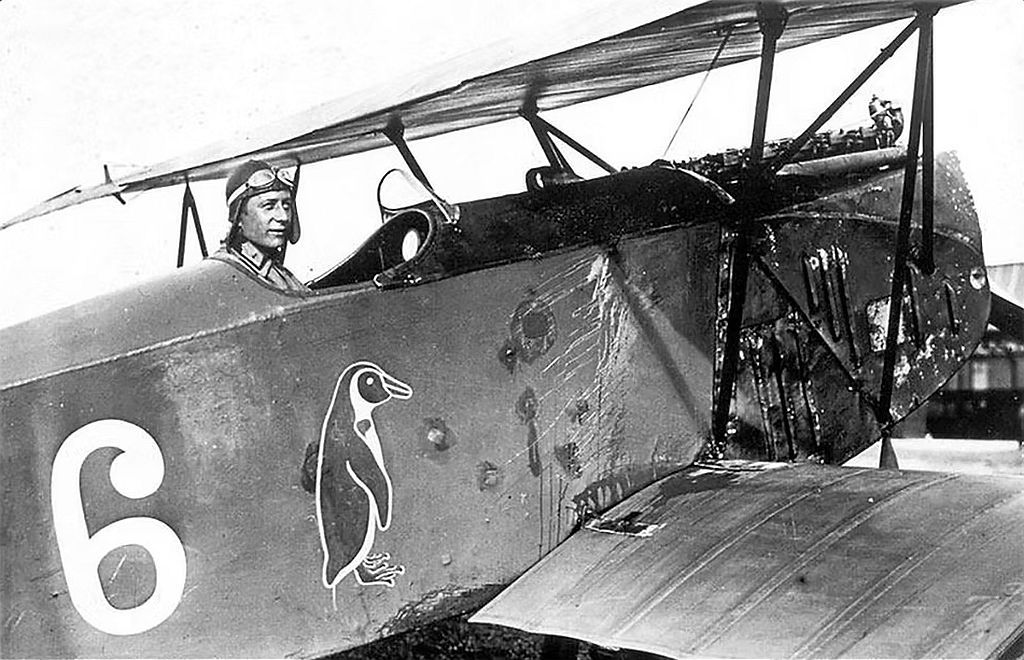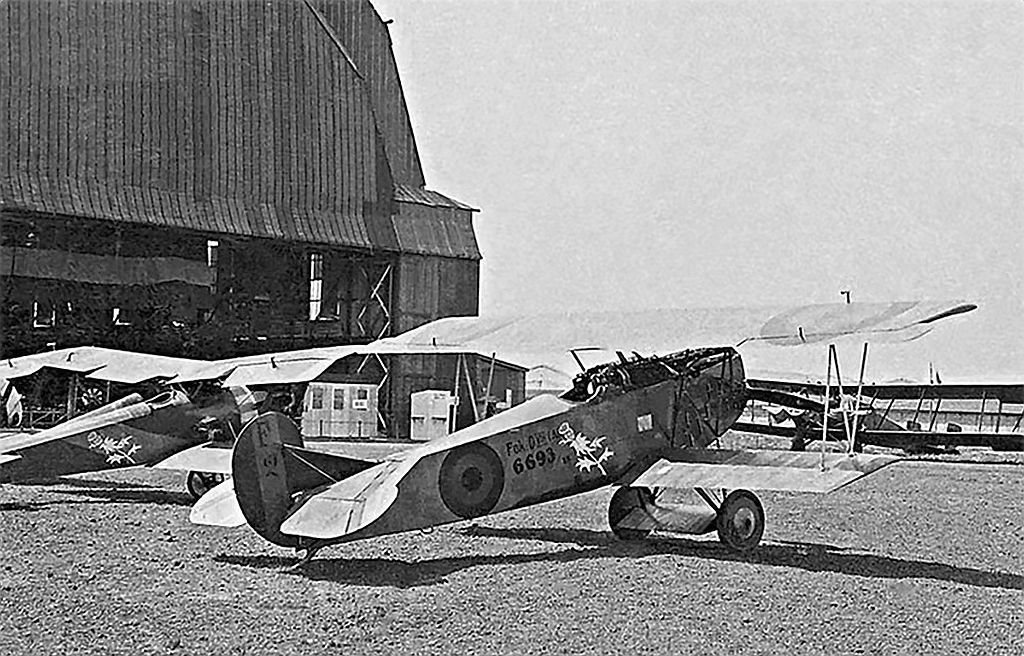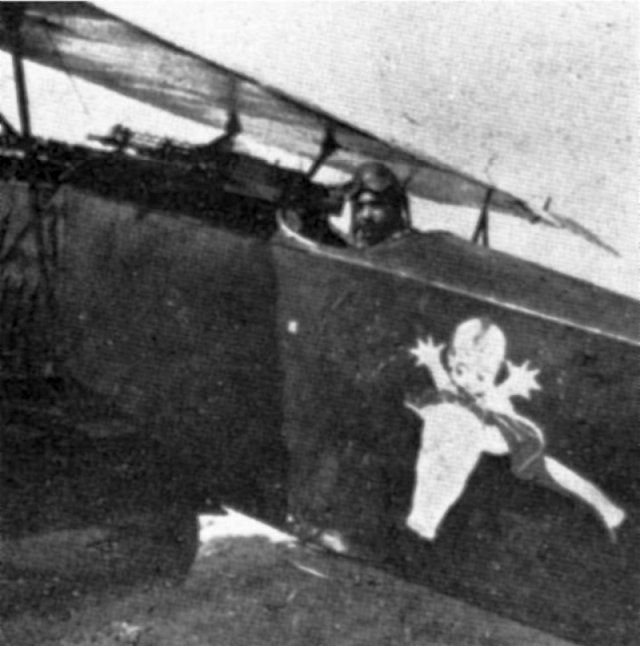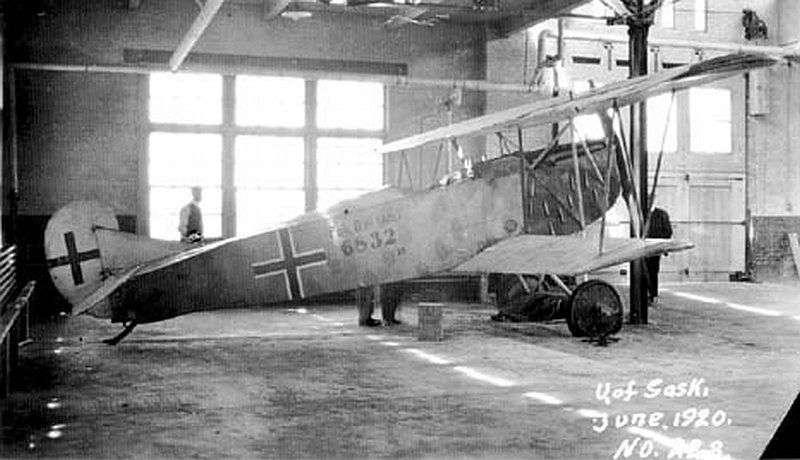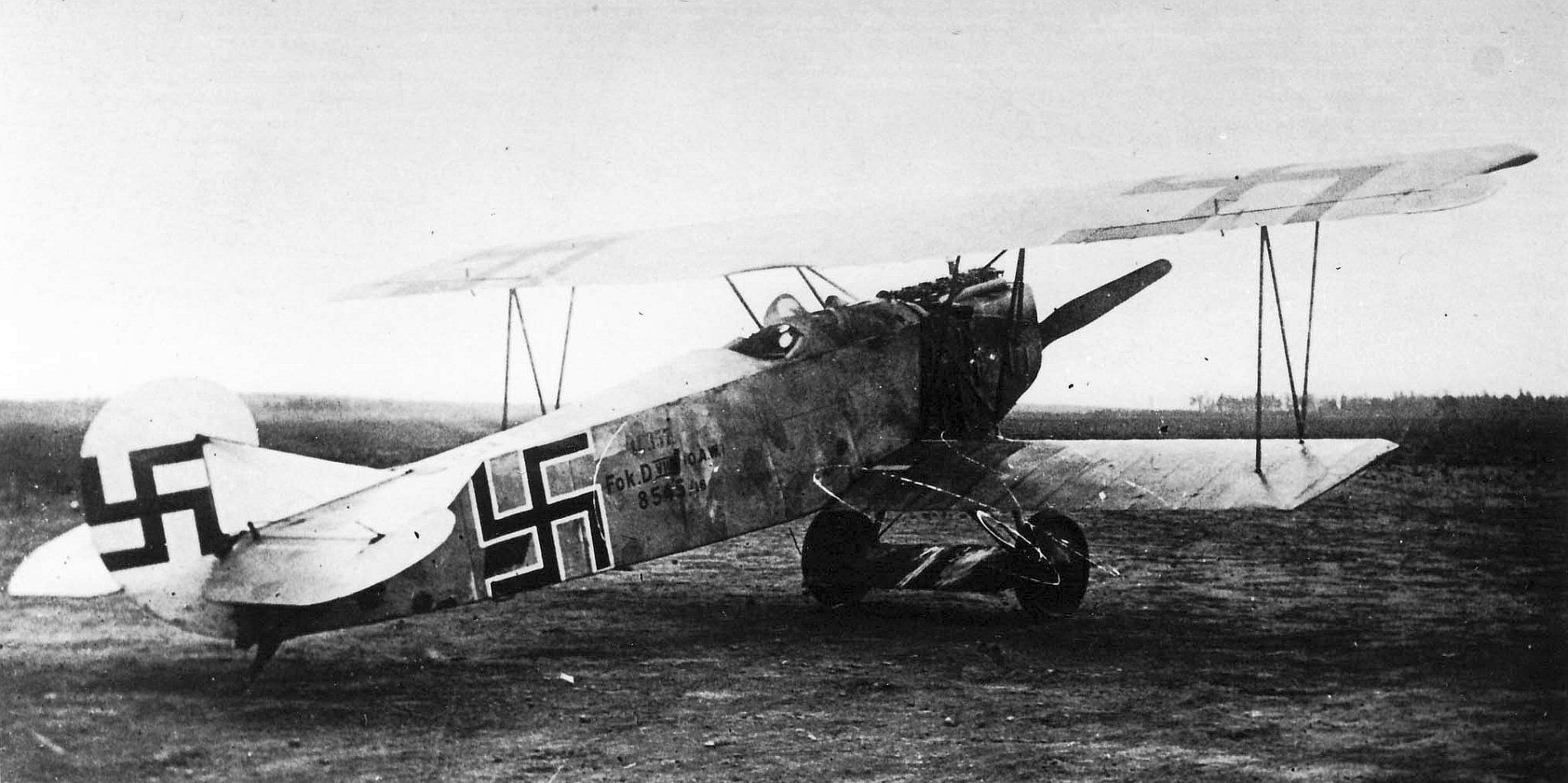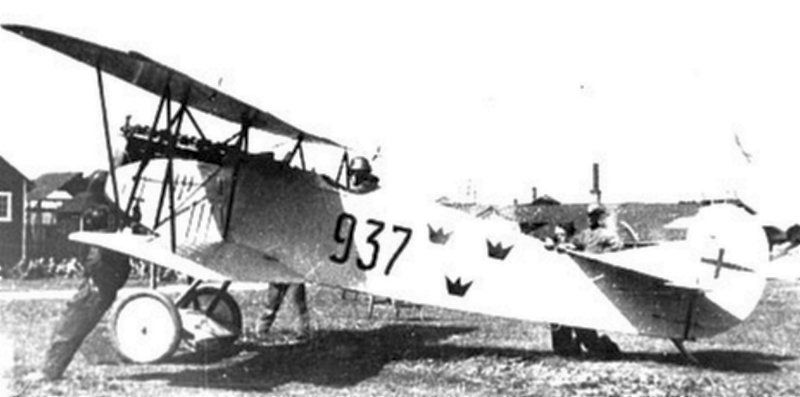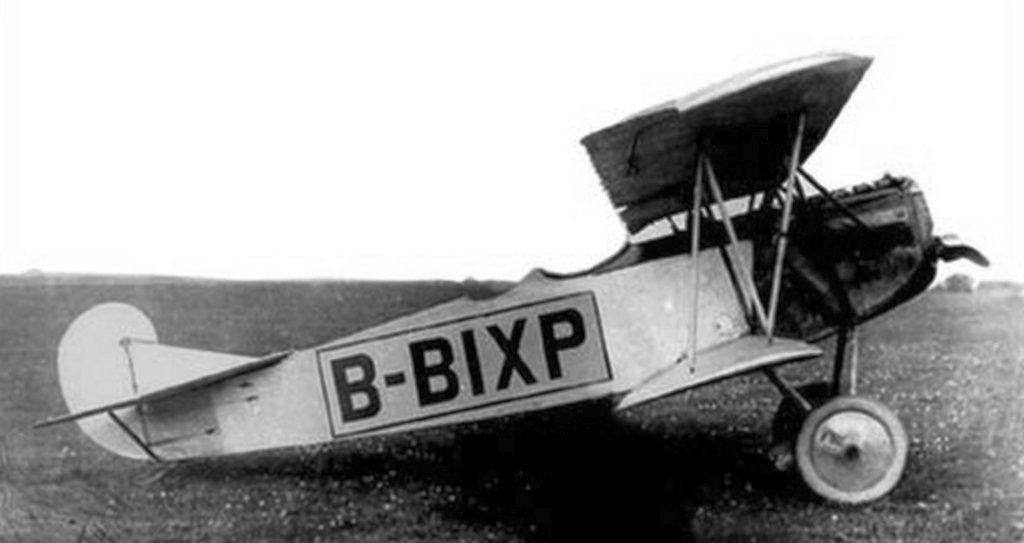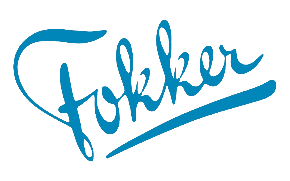-
NL01
One of the very first D.VII fighters to enter service with the LVA after WWII. However, it was already painted with the famous orange stripes in 1919. The photo was taken at the relatively young Soesterberg Airfield. We can assume that this aircraft arrived in the Netherlands on those smuggling trains. This D.VII is the German c/n 5584/18, which was interned in the Netherlands on October 18, 1918. There, this fighter was given the LVA registration F227 and later 227. In November 1919, this D.VII crashed near IJzendijk, Zeeuws-Vlaanderen.
Button
-
NL02
A D.VII, presumably already delivered to the LVA, painted in the familiar solid green at Soesterberg airfield, but without any identification numbers. The very faint outline of the orange dot is visible on the fuselage.
Button
-
NL2.1
Fokker used this two-seater D.VII at the ELTA in Amsterdam in 1919 for sightseeing flights, but apparently it could also accommodate three people.
ELTA Amsterdam
-
NL03
An LVA D.VII, but still in the familiar German Lozenge camouflage colors. The orange dots, the Dutch markings, were already partially present, but still without registration numbers. Incidentally, as part of the internment of German D.VII fighters, six more aircraft with German registrations were included. These were c/n 4001/18, 4293/18, 2994/18, 4144/18, 2176/18, and 4000/18. They were interned near Stein in Limburg on November 13, 1918. From there, they were transported to Schiphol Airport and from there to Soesterberg Airport.
Button
-
NL03.1
D.VIIs for the LVA are collected from the Fokker factory in Amsterdam and transported to Soesterberg. Fokker had no airfield adjacent to the factory. Transport was by water to Schiphol or, as here, by land, hitched to a car to Soesterberg.
Button
-
NL04
The D.VIIF 250 and 256 of the LVA (Luchtvaart Afdeeling) with a 250 hp BMW engine. The 250 entered service on May 14, 1920, and was not decommissioned until March 29, 1938. The 256 entered service on May 12, 1920, and left the LVA on August 7, 1935. The photo was taken at Waalhaven airfield in Rotterdam.
Button
-
NL05
The D.VII 250 and 257 of the LVA at Soesterberg.
Button
-
NL06
Seen from the left, the LVA 257 with a 250 hp BMW engine. It already has the red, white, blue, and orange smokestack, but it's barely visible on the fuselage.
Button
-
NL07
The D.VIIF 251 of the LVA at Soesterberg.
Button
-
NL08
The 251 of LVA with a close-up shot of the two machine guns.
Button
-
NLK09
The LVA's D.VII 253 was forced to make an emergency landing on August 3, 1928, after engine failure. Pilot Vierdag was unharmed.
Button
-
NL10
The installation of meteorological equipment for the KNMI (Royal Netherlands Meteorological Institute) on the 257 at Soesterberg Airport. The 250 hp BMW engine is clearly visible.
Button
-
NL11
Emergency landing of the LVA D.VII 258 near Diemen on October 8, 1926. LVA pilot Brinkhuis was unharmed. Actually, everything turned out quite well. After all, the LVA fighter wasn't decommissioned until October 16, 1935.
Button
-
NL12
Newspaper report of the accident involving the 258. (See previous photo).
Button
-
NL13
One of the few shots of the LVA D.VII fighter 260, which participated in the International Polar Year in Iceland along with the 263. The participation lasted approximately 10 months, from around July 1932 to September 1933, including transport to and from Iceland. Additional FOKKER markings were added to the fuselage, between the registration and the LVA rosette. The 263 was equipped with the 250 hp BMW engine. Among the pilots were Sgt. Flt. Hendrik Bosch and Ltn. Flt. Van der Giessen of the LVA.
Button
-
NL14
A precautionary landing after an engine failure of the D.VII 259 of the LVA in 1931 on the Zuideramstelkanaal (now Stadionkade) in Amsterdam.
Button
-
NL15
A very early shot of the delivery of, in this case, 261 to the LVA. The aircraft is still painted with the orange dot as a national emblem. The truck-trailer combination departed from the brand-new Fokker factory in Amsterdam Noord. After all, the ELTA aviation exhibition had only just ended. The destination was to be the LVA airfield in Soesterberg.
Button
-
NL16
Queen Emma receives an explanation for the D.VII 262 of the LVA.
Button
-
NL17
The LVA's D.VIIF 263 was one of the so-called weather machines. These D.VIIs carried measuring equipment from the KNMI (Royal Netherlands Meteorological Institute) to conduct aerial weather measurements. The measuring equipment was mounted on the right under the wing and on the left between the wings.
Button
-
NL18
Storage of various Fokker aircraft at LVA Soesterberg airfield, after returning from Iceland. In the foreground are LVA aircraft 263 and 260, both of which participated in meteorological competitions and observations in Iceland. This was in honor of the Second International Polar Year in 1932 and 1933. The engines used were 250 hp BMWs. The pilots were Hendrik Bosch and Van der Giessen. From the 1930s onward, this aircraft and the 266 were also used as meteorological hunters in collaboration with the Royal Netherlands Meteorological Institute (KNMI). This was done by LVA pilot Adriaan Viruly, among others, and others in rotation.
Button
-
NL19
The LVA D.VII 265 in front of a tent hangar at Torslanda/Gothenburg airfield, Sweden, in August 1922. The LVA Five Fingers on a Hand also participated in this competition. The LVA D.VII fighters 252, 264, 265, 268, and 263 were deployed. In the center flew the light gray F-600 with squadron leader Willem Versteegh. Also in the picture were pilots Van Weerden Poelman, Jongbloed, Bakkenes, and Van der Griend.
Button
-
NL20
The LVA's D.VII 266, one of the weather machines. The KNMI (Royal Netherlands Meteorological Institute) in De Bilt was delighted with it every day. From Soesterberg, Adriaan (Jons) Viruly and other LVA aircraft flew up to approximately 5,000 meters. This 266 and the 263 were flown every other day.
Button
-
NL21
The LVA D.VII 267 with a converted Model T Ford as a tanker. On the right in the photo is LVA Adjutant Preusser, who was involved in this tank's construction.
Button
-
NL22
An unfortunate emergency landing in a front garden of the D.VII 270 of the LVA.
Button
-
NL23
The two-seat D.VII, registration F600, was a gift from Anthony Fokker to First Lieutenant-pilot Versteegh of the LVA. The F600 was the lead aircraft in Lieutenant Versteegh's LVA aircraft formation "Five Fingers on One Hand."
Button
-
NL26
Sergeant J. Bakkenes of the Dutch Air Force (LVA) on a still German-camouflaged Fokker D.VII with a Dutch cockade. He has just broken the Dutch altitude record at Soesterberg airfield in 1921, reaching 7,904 m.
Button
-
NL27
The Fokker D.VII 269 of the LVA Aviation Department in front of one of the Soesterberg hangars. The photo must have been taken in or around 1922. The LVA men present are trying very hard not to appear too interested. The man in the bowler hat was Mr. Cannegieter of the KNMI (Royal Netherlands Meteorological Institute), who was taking weather measurements. The device on the tripod is a theodolite, a device also used for land surveys, but here it is used to measure the trajectory of the pilot balloon. A pilot balloon is a balloon used in meteorology to determine the height of a cloud measured from the ground surface. The principle behind the pilot balloon is that the balloon's rate of ascent is known and the time it takes for the balloon to disappear into the cloud is measured.
Button
View more
Due to the great importance of the D.VII fighters, we provide an overview of the LVA D.VIIs.
We divide this into 2 types, namely:
• the interned aircraft from Germany
• the group of D.VIIs delivered via Amsterdam
The interned aircraft from Germany up to 1918.
In service with LVA October 1918 c/n 5584/18 Interned LVA registration number F227 later 227,
crashed near IJzendijk in the Sluis region (Zeeland Flanders) November 1919.
160 hp Mercedes engine. Built under license by Albatros
Entered service with LVA on November 18, 1918. Ex c/n 4001/18. Interned at LVA via Stein (Limburg) to Schiphol. Deregistered at the end of 1919.
Entered service with LVA on November 18, 1918. Ex c/n 4293/18. Interned at LVA. Via Stein to Schiphol. Deregistered at the end of 1919.
Entered service with LVA November 18, 1918 Ex c/n 2994/18 Interned LVA Via Stein to Schiphol. Registration number F228 later 228. Deregistered at the end of 1919.
Entered service with LVA November 18, 1918 Ex c/n 4144/18 Interned LVA Via Stein to Schiphol. Registration number F229 later 229. Deregistered at the end of 1919.
Entered service with LVA on November 18, 1918. Ex c/n 2176/18. Interned at LVA. Via Stein to Schiphol. Deregistered at the end of 1919.
Entered service with LVA on November 18, 1918. Ex c/n 4000/18. Interned at LVA. Via Stein to Schiphol. Deregistered at the end of 1919.
These Fokker D.VII fighters were probably also active at Soesterberg airfield.
The D.VIIs delivered via Fokker Amsterdam from 1920 onwards.
In service
with LVA license plate Out of service
17-05-1920 250 29-03-1938
22-05-1920 251 31-05-1929
21-05-1920 252 18-05-1925
25-05-1920 253 1930
04-05-1920 254 1924
14-05-1920 255 1920
12-05-1920 256 1935
21-05-1920 257 1938
05-05-1920 258 1935
20-05-1920 259 1938
24-05-1920 260 1938 participant Polar Year Iceland 1932
04-05-1920 261 1922
14-05-1920 262 1931
03-06-1920 263 1937 participant Polar Year Iceland 1932 and KNMI weather hunter.
June 14, 1920 264 1927
27-05-1920 265 1933
05-05-1920 266 1935 KNMI weather hunter
05-05-1920 267 1935
08-06-1920 268 1938
21-05-1920 269 1927
21-05-1920 270 1936
21-05-1920 271 1930
Netherlands MLD
-
MLD-01
D.VIIs at the front of the Fokker factory on Papaverweg in Amsterdam Noord, ready for delivery to the MLD (Naval Aviation Service). They are ready for departure by water to the Fokker hangar at Schiphol Airport. From left to right, they are the D-20, D-21, D-22, D-23, D-24, and D-25, already equipped with the orange stripes. The intention was to defend the naval city of Den Helder. The MLD would take delivery of the D-20 through D-39 in 1920. Only the D-40 would be the last to be built in-house from spare parts. The basic engine was the 185 hp BMW IIIa, which was not replaced by the 250 hp BMW IV until 1926.
Button
-
MLD-02
D.VIIs for the LVA and the MLD are collected from the Fokker factory in Amsterdam and transported to Soesterberg or Schiphol Airport. Fokker did not have an airfield adjacent to the factory in Amsterdam Noord. Transport was by water to Schiphol or, as here, by land, hitched to a car to Soesterberg Airport.
Button
-
MLD-03
Flight line of some of the MLD D.VIIs at De Kooij airfield near Den Helder. Since 1921, they have been wearing the red-white-blue-orange cockade. Among the aircraft on display are the D-28, D-33, D-31, D-34, and D-20.
Button
-
MLD-05
Now at the rear of the Fokker factory, bordering the Van Hasselt Canal, are MLD D.VIIs that will be transported by barge from the Fokker factory to the Fokker hangar at Schiphol Airport. There, they will be assembled and then flown on to De Kooij air base. These include the D-21, D-25, D-22, and D-20. The orange roundel is on the fuselage.
Button
-
MLD-06
The D.VII fighters D-20 and D-30 of the MLD with the BMW engine; the engine plating is aerodynamically shaped. As is the unusual section on the fuselage behind the pilot's head in the cockpit. Such a thing would rarely be added later. A MLD invention after all? Both aircraft belong to the Blue Ribbon (Blue Band) squadron. The front one, the D-20, is flown by Corpsman E. Schukking. The rear one, the D-30, is flown by Off. Pilot P. van der Grinten.
Button
-
MLD-07
Crash of the MLD D.VII D-22, here still with the orange dot, which would later be replaced by the tricolour roundel.
Button
-
MLD-08
The D.VII D-23 of the MLD also crashes due to this nose attitude.
Button
-
MLD-09
The D.VII D-23 of the MLD.
Button
-
MLD-10
Formation flight of the MLD D.VII's D-21 and D-23, with the cockpit backrest clearly visible. The D-23 doesn't have the blue ribbon, but the D-21 does, along with the D-20, D-24, D-25, D-30, and D-34. The painted-on blue ribbon was strongly reminiscent of BLUE BAND, the Unilever margarine brand. The participants performed in varying compositions. Light sponsorship? We think so. Why not?
Button
-
MLD-11
The D.VIIF D-24 of the MLD with dark colored engine plating.
Button
-
MLD-12
A Pander D in the foreground, with the D.VIIs D-26 and D-27 of the Royal Netherlands Air Force (MLD) at De Kooij flying behind it during a flying display. Also on display is the Fokker S.III, numbered S-8. The Pander D was the P-1 purchased along with the P-2 to save fuel during exercises. On January 19, 2027, the P-2 carrying Captain M. Lievense crashed. And those savings probably didn't amount to much.
Button
-
MLD-13
The D.VIIF D 29 of the MLD.
Button
-
MLD-14
D-29 of the MLD crashed.
Button
-
MLD-15
D-35 of the MLD. Below are some crashed D.VII fighters of the MLD: • On May 2, 1930 near Den Helder, the D-21 flown by Lt. Fl. H. Klaver. • On July 20, 1936 near Texel, the D-24 flown by Lt. Fl. K. van Mulligen. • On July 16, 1937 near MVK De Kooij, the D-29 flown by Off. Fl. M. Holewijn.
Button
-
MLD-16
D-35 of the MLD followed by two Fokker C.Is, also of the MLD.
Button
View more
Fixed data Fokker D.VII based on BMW IIIa engine of 185 hp
Wing 8.92 m, Lower wing 7.01 m, Wing area 21.5 m2, Length 6.93 m
Height 2.79 m, Empty weight 699 kg, Payload 179 kg
Total weight 878 kg, Landing speed 85 km/h, Cruising speed 160 km/h
Max. speed 200 to 220 km/h, range 425 km, 2 Spandau machine guns 7.2 mm
Ascent to 1000 m in 4.15 minutes, 3000 m in 13.49 minutes, 5000 m in 38.5 m
Dutch East Indies LA/KNIL
-
KNIL-01
Five LA-KNIL fighters (Royal Netherlands East Indies Army Aviation Department). D.VIIs in formation over Bandung, Dutch East Indies. From top to bottom: F-303, F-301, F-304, F-302, and F-305. The whereabouts of the sixth D.VII remain unknown.
Button
-
KNIL-02
The same LA-KNIL formation over Bandung, but then over the government buildings.
Button
-
KNIL-03
Flightline of the LA-KNIL D.VIIs without LA-KNIL markings.
Button
-
KNIL-04
In June 1920, the LA-KNIL Aviation Department of the KNIL ordered its first true fighter aircraft from Fokker Amsterdam. Six were ordered, and they entered service in 1922. They were designated F-301, F-302, F-303, F-304, F-305, and F-306. The engine of choice was the 230 hp Armstrong-Siddeley Puma. Assembly and initial testing did encounter some challenges, primarily due to the hot Indonesian climate. This was something the famed D.VII rarely encountered in Europe.
Button
-
KNIL-05
The previous photo and this one show the first "Indische" D.VII, the F-301, which received work number 41 from the assembly plant on Andir. All LA-KNIL D.VIIs subsequently received work numbers 42, 43, 44, 45, and 46. Standing in front of this F-301 is Lieutenant Pilot Willem Giel (1884-1923) of the LA-KNIL, born in Surabaya and a skilled pilot. He gained recognition at the ELTA exhibition in Amsterdam in 1919. There, as an observer, he flew a star flight for military personnel with Officer-Pilot Van Heijst of the (Dutch) LVA and came in second.
The ELTA
-
KNIL-06
On the far left of Kalidjati airfield in the Dutch East Indies in 1922 are the LA-KNIL D.VIIs. They are the F-301 with WN 41 and the F-303 with WN 43. Although they were the first true fighter aircraft, their careers were short.
Button
-
KNIL-07
Here's a nice action shot of the F-302, work number 42. The D.VII fighters, highly valued in Europe, were quickly withdrawn from service. The F-301 in 1926, the F-302 in 1927, the F-303 in 1928, the F-304 in 1927, the F-305 in 1927, and the F-306 in 1926.
Button
-
KNIL-08
Display of five of the six D.VII aircraft delivered. Already equipped with the 230-hp Armstrong-Siddeley Puma. Of the nine D.VII aircraft ordered, six were delivered. The whereabouts of the sixth remain a mystery. It did arrive in the Dutch East Indies.
Button
-
KNIL-09
The D.VII fighters shipped to the Dutch East Indies were painted dark green. The markings, such as registration, letters, and numbers, were marked "Dutch East Indies."
Button
-
KNIL-10
A beautiful front view, that's for sure, but the plane had quite a few problems, especially with the Armstrong Siddeley engine.
Button
-
KNIL-11
Right-side view. Still just before departure by ship. The abbreviation LA/KNIL stands for Aviation Department Royal Netherlands East Indies Army. It was originally PA/KNIL, or Pilot Department of the Royal Netherlands Army. Much later, in the late 1930s, it was renamed ML/KNIL Military Aviation of the KNIL.
Button
-
KNIL-12
The Armstrong Siddeley Puma engine stripped of its engine plates. This photo was likely taken at Soesterberg airfield. In the background is a Fokker CI, the 508 of the LVA, with the orange dot.
Button
-
KNIL-13
A beautiful aerial shot above the partially completed government buildings in Bandung. Flying from top to bottom are the F 303, F 301, F 304, F 302, and below them (partially visible) the F 305.
Button
-
KNIL-14
Here flies the F 302 with the White Cat sign of the squadron on the tailplane.
Button
-
KNIL-15
There is great interest here for a visit by the F-301.
Button
-
KNIL-16
The Dutch approach to road transport was also applied at the Royal Netherlands East Indies Air Force (LA/KNIL). The hangars used looked excellent.
Button
View more
Fokker Amsterdam-Noord
-
FN-01
The D.VII with the civilian registration PH-AJW was a two-seater and a private D.VII owned by Anthony Fokker. (wn 3621) This is believed to be Lieutenant Versteegh's F600, which he returned when he left for the Dutch East Indies. This is also possibly the same two-seater D.VII that Fokker used at the ELTA in 1919 for sightseeing flights (First Air Traffic Exhibition Amsterdam).
Button
-
FN-02
PH-AJW was regularly stationed at the Fokker hangar at Schiphol-Oost. Later renamed the Fokker Vliegbedrijf (Fokker Flying Company). The D.VII PH-AJW had a larger wingspan and a fuel tank between the landing gear. This fighter was also registered as a private aircraft from May 26, 1934, to June 30, 1937. It likely flew temporarily in LVA colors with registration 497.
Button
View more
Russian D.VIIs
In 1922, fifty D.VIIs were sold by Fokker to Soviet Russia.
These aircraft had once been part of the famous train transport from Schwerin to Amsterdam in 1919.
The construction numbers were 10, 20, 25, 31-33, 38, 40, 45, 49-52, 54, 56-75, 82-88 and 92-100.
These fifty D.VIIs, together with three CIs, were transported on the steamers Warschau and Johanna to Petrograd (St. Petersburg), where they arrived on 16 May 1922.
The aircraft were delivered as a kit, with the fuselage and wings packaged separately. Fokker mechanic Hans Schmidt assisted with assembly in Russia.
The D.VIIs were stationed in Petrograd and Kiev. In 1925, they were replaced by Fokker D.XIs, but remained in service as training aircraft. The last one was scrapped in 1931.
In Russia the F.VII was known as the FD-VII.
Sources Russian D.VII:
Hugo Hooftman (1962): From Brik to Starfighter Part 1
Lennart Andersson (1994): Soviet Aircraft and Aviation 1917-1941
Gennady F. Petrov (2014) : Поколение Чкалова (The Chkalov Generation) 1920-1930
Andrej Averin (2021): email correspondence
-
R01
These D.VIIs bear red stars on their wings. A bunch of grapes is painted on the keel.
Button
-
R02
A squadron of five Russian D.VIIs. The second one ('1') just shows the bunch of grapes. No. 1 is on the left and No. 4 is on the right.
Button
-
R03
Upside down in the water. The red stars were also applied to the underside of the wings.
Button
-
R04
Three D.VIIs ready for takeoff. The "4" is painted in a different style than in photos 1 and 2.
Button
-
R05
Refueling in winter.
Button
-
R06
A line of Russian pilots pose in front of a D.VII.
Button
-
R07
Group photo. Serpukhov Flight School, 1927
Button
-
R08
This close-up shows that the D.VII in photo 7 was equipped with British Vickers machine guns, not German Spandaus.
Button
View more
United States
After the armistice on November 11, 1918, American troops began rapidly confiscating German aircraft and shipping them to America. The largest number of these were D.VIIs, with several brand-new aircraft from various production lines also being seized.
When the Treaty of Versailles was later concluded and the American Congress refused to sign it, they lost their right to share in the spoils of war, which included many D.VIIs.
However, the nearly 150 D.VIIs that had already found their way to America remained there.
In April 1919, three sets of five D.VIIs were first shown to the American public at Victory Loan Drive. The purpose of this drive was to subscribe to a government loan. The aircraft still flew in their full German colors, and many other D.VIIs in service with the Army Air Service continued to do so for years to come.
Several were fitted with American Liberty, Packard, or Hall Scott engines and extensively tested. Several aircraft manufacturers also obtained these Fokkers, particularly for research into the construction of steel tube fuselages.
A limited number of the decommissioned D.VIIs went to private individuals, but the number of airworthy aircraft declined rapidly over the years.
After all, the film industry was still a major user of refurbished D.VIIs in the late 1920s. Several were still seen in "Hell's Angels," in particular. These were supplemented by converted Travel Airs known as "Wichita Fokkers."
-
VS-01
An OAW (East German Albatross Werke) built D.VII at Hazelhurst Field, LI in 1919
Button
-
VS-02
The Hall Scott Engine Company equipped the 8503 with their L-6 engine, seen here at Durand Field, Oakland, California in July 1920.
Button
-
VS-03
The unfortunate 7795 from Langley Field that collided with a Curtiss NBS-1 in flight, killing six.
Button
-
VS-04
One of the Marine Corps' two D.VIIs, just fitted with new hull lining
Button
-
VS-05
D.VII of the Marine Corps with number 5845 on the tail in the USA.
Button
-
VS-06
The D.VII 8323/18 in the USA with McCook field number P 127.
Button
-
VS-06.1
D.VII with a ski undercarriage.
Button
-
VS-07
The D.VII AS94034 in the USA, bearing McCook field number P 290 and equipped with a Packard Liberty engine. The name AS stands for Army Air Service.
Button
-
VS-08
The D.VII AS 8530 in the USA with a Hall-Scott L6 engine.
Button
-
VS-09
D.VII flown over Long Island NY USA by Lieutenant Barksdale.
Button
-
VS-10
The D.VII 8508 from the Hall Scott factory was a single-seater with an additional tank in the front seat. The fuselage was marked "Hall Scott Fokker" and "L G.Engine." (Gasoline).
Button
-
VS-11
Front view of the 8403 at McCook Field with a Packard Liberty engine.
Button
-
VS-12
Five months after the armistice of World War I, these three D.VIIs stand in San Francisco USA on April 12, 1919.
Button
-
VS-13
A D.VII in the USA of the NACA, National Advisory Committee for Aeronautics, now NASA, National Aeronautics and Space Administration, the D.VII is ex 6328/18. In the Netherlands it can be compared with RSL, the Netherlands Aerospace Centre (NLR).
Button
-
VS-14
The Fokker factory purchased this D.VII from the American "Wings and Wheels" museum on December 5, 1981, for $45,000. At the time, it bore the American registration N4729V; originally, it was number 436/18 with registration number 2523 from 1918. After restoration by Fokker and the Royal Netherlands Air Force, this D.VII was displayed as number 266 at the then MLM (Military Aviation Museum) in Kamp Zeist. The photo shows the D.VII after its arrival by sea container via Rotterdam at Fokker's Experimental Department.
Button
-
VS-15
Although the AS7728 was, according to all sources, shipped to Canada, it appears to have ended up in America.
Button
-
VS-16
The 5845 of the US Marine Corps nicknamed “Hans”.
Button
-
VS-17
7756/18 with wn 3608 in full German livery at Kelly airfield in the USA, after World War I. At the end of World War I, many German fighter aircraft were covered with LOZENGE cloth, a camouflage cloth that was pre-printed in the factory.
Button
-
VS-18
The D.VII 7776/18 with wn 3628 in the USA with McCook field number P 108.
Button
-
VS-19
Once again the D.VII 7776/18 at McCook field
Button
-
VS-20
The U.10' was captured by the Americans, still bearing the German registration 4635/18. This was in late 1918 or early 1919. This D.VII was actually a D.VII F. After restoration, this fighter is housed in the National Air Museum on the Mall in Washington.
Button
View more
Belgium
-
B01
The Fokker D.VII, the former German D.VII 6162/18, now bears the Belgian civilian registration O-BEBE. It is possible that these civilian aircraft first served with the Belgian Air Force from 1919 onwards. Incidentally, at the end of World War I, the following loot distribution was allocated to the Allies under the Treaty of Versailles. This specifically involved the distribution of Fokker D.VII fighter aircraft: Great Britain, the United States, and France each received 160 fighters. Belgium received 57, Australia 22, and Canada 22.
Button
-
B02
The D.VII F 13 of the Belgian Air Force, along with a large squadron. The F 13 was in service from 1919; its end date is unknown. The F 13 operated at the Asch (east of Genk) and Wevelgem (near Kortrijk) flying schools.
Button
-
B03
The D.VII F 34 of the Belgian Air Force entered service in August 1922, but its end date is unknown. The F 34 served at the flying schools in Asch and Wevelgem. Note the wheels with the American star, which dates back to World War I.
Button
-
B04
The Fokker D.VII, formerly German 7226/18, work number 3478, now with the Belgian civil registration O-BILL, is on the left. On the right: the Fokker D.VII, formerly German 6162/18, now with the Belgian civil registration O-BEBE. The date of decommissioning for both aircraft is unknown.
Button
-
B05
The Fokker D.VII, formerly German 7684/18 work number 3478, now with the Belgian civil registration O-BABY. There were many other registrations, such as O-BISE, O-BOBE, O-BAFA, and O-BLUF.
Button
-
B06
The Fokker D.VII, a former German aircraft with the famous Lozenge camouflage livery. This livery was increasingly used between 1917 and 1918, as was the case with this 7684/18. Aircraft like this saw action with the Fliegertruppe until the end of 1918. This aircraft was still active in 1919 around Bockum-Krefeld, Germany.
Button
-
-
-
-
-
-
View more
Poland
-
PL01
The Polish Air Force's "FOK.D.VII .18 – 7." with pilot Jerzy Kossowski. (.18 was the year of manufacture). The "I Polski Oddzial Awiacyjny" (First Polish Aviation Squadron) was established in 1918–1920 in Minsk (later located in Belarus).
Button
-
PL02
The Fokker D.VII with its unusual paint scheme, active in Poland. The number of D.VII fighters in service in Poland is unknown.
Button
-
PL03
This Polish D.VII still had the German registration Fok D.VII 542?/18. The fighter had a sideways V and the red and white country markings. This suggests the aircraft also saw action in Hungary.
Button
-
PL04
A substantial contingent of Polish D.VII fighters was desperately needed due to the impending Polish-Russian War of 1919-1921. After the Treaty of Versailles in 1919, six aircraft initially arrived, eventually increasing to fifty. All were destined for the Sily Powierzne Rzczypospolitej. From the large French contingent, another 20 Fokker D.VII aircraft were later added.
Button
View more
Austria-Hungary
-
OH-01
The KuK (Imperial and Royal Luftfahrtruppen), founded in 1912, had an airfield near Wiener Neustadt, and was disbanded at the end of 1918. Austria and Hungary separated after World War I. Therefore, approximately 50 D.VII fighter aircraft must have been briefly active until the end of 1918. This photo shows a D.VII with red stars on the wings and fuselage.
Button
-
OH-02
The Air Force, or Luftfahrt truppen, was established in 1913. This was due to the widespread use of hot air balloons. Only later were aircraft purchased, including the Fokker D.VII, six of them. The engines used were the 210 hp Austro-Daimler. And the number could easily reach 35, with Hungary securing the lion's share.
Button
-
OH-03
All three photos feature varying captions, such as those in photo OH-01, even Russian texts. The stars on the fuselage, wings, and tail may also be related to this. We suspect the Soviet Union is the source of all those stars. The number 8 undoubtedly represents a squadron or group. Furthermore, this all seems to indicate a division between various new countries. At the end of 1918, the Austro-Hungarian Empire collapsed completely. New countries emerged. The Dual Monarchy consisted of modern-day Austria, Hungary, Bosnia and Herzegovina, Croatia, the Czech Republic, Slovakia, Slovenia, and parts of Italy, Montenegro, Poland, Romania, Serbia, and Ukraine.
Button
View more
Denmark
-
DM-01
A D.VII in Danish service, used there for training purposes at Flyvevâbnet. The German registration has already been painted over, but otherwise it's still easily recognizable as a former German fighter. Denmark bought an aircraft in 1922, indeed.
Button
-
DM-02
Not long after, Dansk Luft Rederi, a sightseeing flight company, purchased two D.VIIs. These were used for private flights within Denmark. True military flying didn't really take off until much later. But then we're talking about the late 1920s and early 1930s.
Button
View more
-
PL19
A D.VII registered with number 37 for Lithuania.
Button
-
pl32
In Lithuania, the army and air force have been one entity for a long time under the name Karinès Oro Pajègos.
Button
-
pl33
A serious accident involving a Lithuanian D.VII. The double-crossed coat of arms is clearly visible. Incidentally, only a few D.VII fighters would have seen service for a short period. This would have been between 1919 and around 1924. This was all related to Russia/the Soviet Union, a brief period of independence, and the German advance.
Button
View more
Other countries
-
France 01
Probably a museum display of a former German (Albatross) Fokker D.VII. It was one of the captured Fokker D.VII fighters. This conquest, through the Treaty of Versailles, included a total of 160 fighters between 1919 and 1920.
Button
-
France 02
Also from the large booty, but unfortunately quite illegible. Twenty hunters from the French loot ultimately went to Poland.
Button
-
-
Canada 01
Beautifully displayed here is the ex 6810/18 from Germany. It's in the Canada Broome Country Museum.
Button
-
Canada 02
Here's a photo from June 1920 of the former German 6832/18. Canada received 22 aircraft from the spoils of the Treaty of Versailles in 1919-1920.
Button
-
-
Finland 01
Here is the first D.VII, assigned to the Finnish Air Force. (IImavoimat) It was the ex-German 8545/18, built under license for Fokker by the OAW (Ostdeutsche Albatros Werke). Three were purchased in 1919 and remained in service until around 1924. During that period, the marking was a swastika, or rather a horizontal swastika. In 1945, the Finns switched to the round white-light-blue-white marking.
Button
-
Finland 02
In a more colorful version and with the mysterious registration ID. 357—yes, you name it. Only later in the interwar period did Fokker begin selling larger numbers of aircraft to Finland. See the Fokker C.X and the D.XXI for example. This took place at Fokker Amsterdam and under license in Tampere. Incidentally, the D.VII fighters were equipped with 160 hp Mercedes engines. Four engines were purchased for this purpose.
Button
-
-
Switzerland 01
Registration number 608 of the Swiss Air Force; the Schweizer Luftwaffe / Forces Aériennes Suisses. Above, the first delivered Fokker D.VII, the 608. Along with the 609, these two fighters were delivered to Dübendorf airfield in 1920. In 1922, another 17 Fokker D.VII fighters followed, built at the factory in Amsterdam Noord. The permanent registrations were 610 through 624. The Swiss Captain/pilot Barsch won the Tour des Alpes in 1922 with one of these D.VII fighters. In 1929, the Swiss company COMTE built another 8 aircraft under license, namely the 625 through 632. A total of 27 fighters were delivered. The 631 was originally the German 4253/18 and later became the Swiss 631. Eventually, the German pilot Ernst Udet purchased the aircraft as D-EIRA. From 1938 onwards, the fighters were gradually deregistered.
Button
-
Sweden 01
The Swedish Air Force was founded in 1912 as part of the army. It wasn't until 1919 that an independent air force, the Flygvapnet, was established. At the end of World War I, Hermann Göring flew a German D.VII to Sweden (reg. 7716/18 and 185 hp BMW engine). The aircraft arrived in Sweden either deliberately or accidentally and was eventually incorporated into the Flygvapnet. It remains a question whether Sweden flew more Fokker D.VII fighters. In any case, this is the 937 of the Swedish Air Force, still bearing the flag on the tail and the three crowns on the fuselage and wing.
Button
-
Czechoslovakia 01
After the collapse of Austria-Hungary, several Eastern European countries became independent. After 1918, Czechoslovakia was among them. A few D.VII aircraft were based at the first Kbely air base near Prague. Little else has been reported on this so far. No registration is visible on the fuselage or wings; only the red, white, and blue national emblem is visible on the tail. The round red, white, and blue cockade is (or has been pecked?) similar to the Dutch one, but without the orange ball.
Button
-
Great Britain 01
One of the British Fokker D.VII fighters that had recently fallen into British hands. The aircraft is still covered with Lozenge canvas and is rather sloppily painted here and there. The Nash Collection will likely acquire this aircraft later. It was the German 5349/18 and built under Fokker license at the Albatros Werke. Under the Treaty of Versailles following the Armistice of World War I, Great Britain acquired 150 Fokker D.VII fighters. This was the same number (150) as France and the United States. Incidentally, we do not yet have any photos of the 22 Fokker D.VII fighters that were transported to Australia.
Button
-
Bulgaria 01
In September 1918, at the end of World War I, Bulgaria became interested in fighter aircraft. They were also looking for a faster mail carrier, and for other Balkan countries as well. Hungary, newly independent, was also interested in air mail transport. To start with ready-made, fast aircraft, they also sought this in Hungary. There they found the Magyar Atalános Gépgyár (MAG), the Hungarian General Machine Company. MAG began at the end of 1918 with a Fokker license order for eight aircraft, equipped with 210 hp Austro-Daimler engines. This number would gradually increase to 50 Fokker-'MAG' fighter and mail aircraft. Hence the civilian registrations, including the B-BIXP with the red-green-and-white roundel on the tailplane. Western countries also carried a considerable amount of airmail, but almost always in the compartments of aircraft carrying cargo and passengers.
Button
View more




